Index Catalog Objects: IC 50 (original) (raw)
QuickLinks:
50, 51, 52, 53, 54, 55, 56, 57, 58, 59, 60, 61, 62, 63, 64, 65, 66, 67, 68, 69, 70, 71, 72, 73, 74,
75, 76, 77, 78, 79, 80, 81, 82, 83, 84, 85, 86, 87, 88, 89, 90, 91, 92, 93, 94, 95, 96, 97, 98, 99
Page last updated Aug 3, 2021
Checked final Corwin positions
Several entries with uncertain IDs (e.g. IC 96/97), several "companions" to deal with
Checked historical references, Dreyer's IC entries
(Note to self: Check Corwin/Thomson notes for 93ff, in case there are some unnoticed problems)
IC 50 (= PGC 2698)
Discovered (Sep 27, 1892) by Stephane Javelle
A magnitude 14.1 elliptical galaxy (type E2?) in Cetus (RA 00 46 05.7, Dec -09 30 11)
Historical Identification: Per Dreyer, IC 50 (Javelle 32, 1860 RA 00 39 03, NPD 100 15.9) is "faint, equal to nebulous 13th magnitude star". The position precesses to RA 00 46 07.3, Dec -09 29 56, less than 0.5 arcmin northeast of the galaxy listed above, the description fits and there is nothing else nearby, so the identification is certain.
Physical Information: Based on a recessional velocity of 6120 km/sec, IC 50 is about 285 million light years away. Given that and its apparent size of 0.75 by 0.6 arcmin, it is about 60 thousand light years across.

Above, a 12 arcmin wide SDSS image centered on IC 50
Below, a 1 arcmin wide SDSS image of the galaxy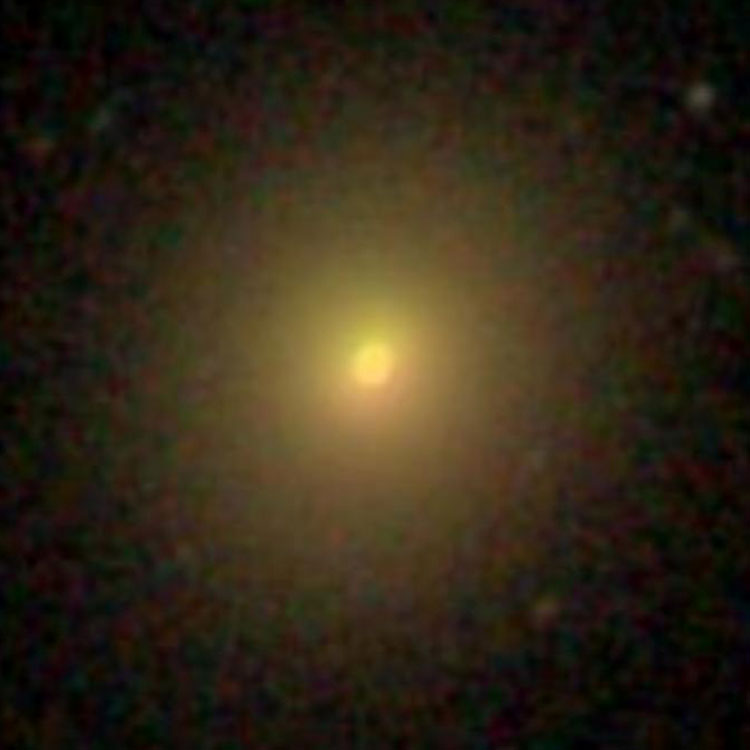
IC 51 (= Arp 230)
(= PGC 2710 = MCG -02-03-011)
Discovered (Aug 30, 1892) by Stephane Javelle
A magnitude 12.8 polar-ring galaxy (type (R'R)SA0/a? pec (PRG)) in Cetus (RA 00 46 24.2, Dec -13 26 32)
Historical Identification: Per Dreyer, IC 51 (Javelle 33, 1860 RA 00 39 22, NPD 104 12.3) is "pretty bright, small, brighter middle, mottled but not resolved". The position precesses to RA 00 46 23.7, Dec -13 26 21, within the disturbed western portion of the galaxy listed above and there is nothing else nearby, so the identification is certain.
Physical Information: Based on a recessional velocity relative to the Cosmic Microwave Background radiation of 1400 km/sec (and H0 = 70 km/sec/Mpc), IC 51 is about 65 million light-years away. Given that and its apparent size of about 0.95 by 0.85 arcmin for the main galaxy and brighter inner shell and about 1.25 arcmin for the fainter partial second shell (from the images below), the galaxy and its inner shell are about 18 thousand light-years across, the partial second shell spans about 24 thousand light-years, and fainter outer shells not visible in any of the images are of unknown but larger sizes.
IC 51 is an example of a polar ring galaxy, apparently the result of a relatively recent (perhaps about 100 million years prior to what we now see) head-on collision between two spiral galaxies. It is expected that eventually the polar ring will disappear and all that will remain is the more nearly elliptical galaxy that is already the main result of the merger. Aside from the distorted ring that is visible in all the images below, the shock of the collision has created a number of shell-like structures that extend well beyond the central galaxy. Since the merged galaxy is relatively small, the spirals whose collision created it must have also been relatively small, and certainly far smaller than our own Milky Way Galaxy, which is more than 100 thousand light-years across.
Usage By The Arp Atlas: IC 51 is used by the Arp Atlas of Peculiar Galaxies as an example of a galaxy with a concentric ring, with the note "Inner and outer shells visible in direction of axis only." As can be seen in some of the images below, the inner shell is more or less complete, but Arp's comment is correct for the next one.
Classification Notes: The Spitzer Survey of Stellar Structure in Galaxies classification is SA(s)b sp / SA0o (PRG?). The "sp" in the first classification means that this is a "spindle" (or "edge-on" galaxy). This is an example of how infrared images, though useful in many cases, can be completely wrong in others; the infrared images only show the distorted ring created by the collision of the two galaxies, which makes it appear to be an edge-on spiral. However, the addition of the alternate classification includes "PRG?", which means that this might be a polar ring galaxy. As seen in the images below, that is a far more accurate classification. The "type" shown in the description line is therefore based on visible-light images and classifications.

Above, a 12 arcmin wide PanSTARRS image centered on IC 51
Below, a 2.4 arcmin wide PanSTARRS image of the galaxy and its shells (the brownish 'line' upper left is an image artifact)
The shells are not shown as well in the HST images, which are optimized for the central galaxy
Below, the same region as the image above, as shown in the Arp Atlas
Note that the high-proper motion star is well to the north of its position in the other images
Below, a 1.1 by 1.2 arcmin wide image of the galaxy (Image credit ESA/Hubble & NASA; Acknowledgement Flickr user Det58)
Below, the same region as a more "natural-color" image (Image Credit Hubble Legacy Archive, Judy Schmidt; used by permission)
IC 52 (= PGC 2834)
Discovered (Aug 19, 1892) by Stephane Javelle
A magnitude 14.5 spiral galaxy (type Sdm? pec) in Pisces (RA 00 48 23.9, Dec +04 05 31)
Historical Identification: Per Dreyer, IC 52 (Javelle 34, 1860 RA 00 41 09, NPD 86 40.8) is "very faint, very small, round, gradually a very little brighter middle". The position precesses to RA 00 48 21.6, Dec +04 05 05, about 0.7 arcmin southwest of the galaxy listed above and there is nothing else nearby, so the identification is certain.
Physical Information: Based on a recessional velocity of 1960 km/sec, IC 52 is about 90 million light years away. Given that and its apparent size of 0.75 by 0.3 arcmin, it is about 20 thousand light years across.

Above, a 12 arcmin SDSS image centered on IC 52
Below, a 1 arcmin wide SDSS image of the galaxy
IC 53 (= PGC 2951)
Discovered (Sep 25, 1890) by Lewis Swift
A magnitude 13.9 lenticular galaxy (type E/S0?) in Pisces (RA 00 50 40.8, Dec +10 36 01)
Historical Identification: Per Dreyer, IC 53 (Swift list X (#3), 1860 RA 00 43 11, NPD 80 08.6) is "most extremely faint, pretty small, round, others suspected". The position precesses to RA 00 50 28.1, Dec +10 37 12, just over 3 arcmin west northwest of the galaxy listed above and there is nothing else in the region that Swift could have seen, so the identification seems certain.
Physical Information: Based on a recessional velocity of 11770 km/sec, a straightforward calculation indicates that IC 53 is about 550 million light years away. However, for objects at such distances we should take into account the expansion of the Universe during the time it took their light to reach us. Doing that shows that the galaxy was about 525 million light years away at the time the light by which we see it was emitted, about 535 million years ago (the difference between the two numbers being due to the expansion of the intervening space during the light-travel time). Given that and its apparent size of 0.8 by 0.6 arcmin, the galaxy is about 125 thousand light years across.

Above, a 12 arcmin wide SDSS image centered on IC 53
Below, a 1 arcmin wide SDSS image of the galaxy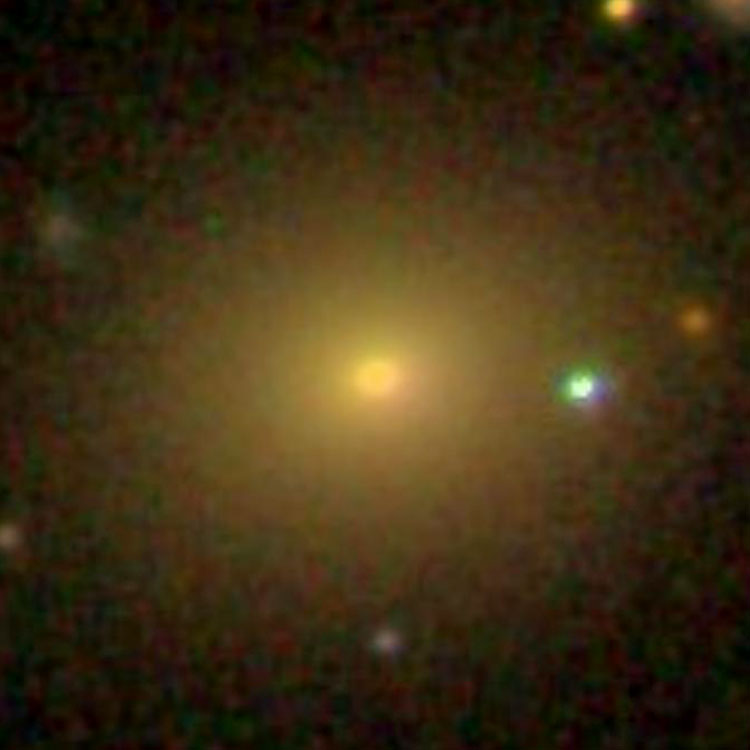
IC 54
Recorded (Feb 13, 1890) by Rudolf Spitaler
A pair of 12th magnitude stars in Cetus (RA 00 50 46.8, Dec -02 17 19)
Historical Identification: Per Dreyer, IC 54 (Spitaler [(A.N.) 2993] (#1), 1860 RA 00 43 38, NPD 93 03.3) is "a nebula or small cluster, 2 arcmin diameter, brighter middle". The position precesses to RA 00 50 46.5, Dec -02 17 31, barely south of the double star listed above, the description fits and there is nothing else nearby, so the identification is certain.
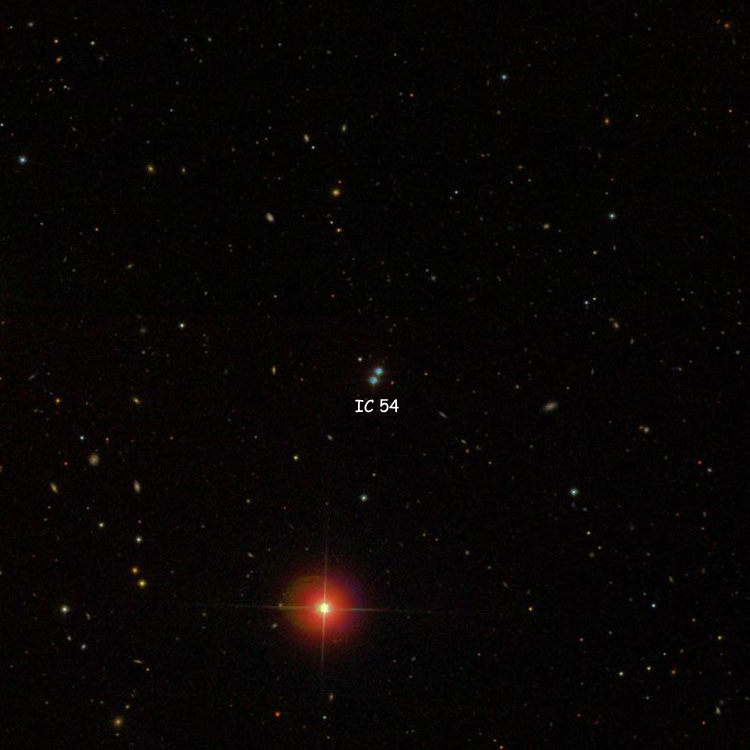
Above, a 12 arcmin wide SDSS image centered on IC 54
IC 55 (= PGC 3025)
Discovered (Nov 10, 1892) by Stephane Javelle
A magnitude 14.1 lenticular galaxy (type S0?) in Pisces (RA 00 51 42.4, Dec +07 43 07)
Historical Identification: Per Dreyer, IC 55 (Javelle 512, 1860 RA 00 44 27, NPD 83 02.6) is "faint, very small, diffuse, 13th magnitude star close". The position precesses to RA 00 51 42.3, Dec +07 43 09, dead center on the galaxy listed above, and the nearby 14th magnitude star makes the identification certain.
Physical Information: Based on a recessional velocity of 5225 km/sec, IC 55 is about 245 million light years away. Given that and its apparent size of 0.8 by 0.45 arcmin, it is about 55 thousand light years across.

Above, a 12 arcmin wide SDSS image centered on IC 55
Below, a 1 arcmin wide SDSS image of the galaxy
PGC 1328284
Not an IC object but listed here as an apparent companion of IC 55
A magnitude 16(?) galaxy (type S?) in a href=pisces.htm#pgc1328284>Pisces (RA 00 51 57.1, Dec +07 41 20)
Physical Information: LEDA B 16.7, K 13.0; NED .68 x .16 arcmin, 3K Vr 4885 km/sec
IC 56 (= PGC 3014)
Discovered (Nov 2, 1891) by Stephane Javelle
A magnitude 14.3 spiral galaxy (type SAB(r)cd?) in Cetus (RA 00 51 30.0, Dec -12 50 40)
Historical Identification: Per Dreyer, IC 56 (Javelle 35, 1860 RA 00 44 29, NPD 103 36.1) is "very faint, small, a little brighter middle". The position precesses to RA 00 51 30.2, Dec -12 50 21, on the northeastern rim of the galaxy listed above and there is nothing else nearby, so the identification is certain.
Physical Information: Based on a recessional velocity of 6085 km/sec, IC 56 is about 285 million light years away. Given that and its apparent size of 0.75 by 0.75 arcmin, it is about 60 thousand light years across.

Above, a 12 arcmin wide DSS image centered on IC 56, also showing PGC 3035
Below, a 1 arcmin wide DSS image of the galaxy
PGC 3035 (= "IC 56A")
Not an IC object, but listed here since sometimes called IC 56A
A magnitude 15.7 spiral galaxy (type SBm?) in Cetus (RA 00 51 51.3, Dec -12 46 02)
Warning About Non-Standard Identification: Although PGC 3035 is often referred to as IC 56A, there is no connection between it and IC 56. They were not discovered together, are not particularly close to each other in the night sky, and the PGC object is nearly three times as far away. So any inference of a connection because of the incorrect use of an IC designation is completely baseless.
Physical Information: Based on a recessional velocity of 12560 km/sec, a straightforward calculation indicates that PGC 3035 is about 585 million light years away. However, for objects at such distances we should take into account the expansion of the Universe during the time it took their light to reach us. Doing that shows that the galaxy was about 555 million light years away at the time the light by which we see it was emitted, about 570 million years ago (the difference between the two numbers being due to the expansion of the intervening space during the light-travel time). Given that and its apparent size of 0.4 by 0.3 arcmin, the galaxy is about 65 thousand light years across.
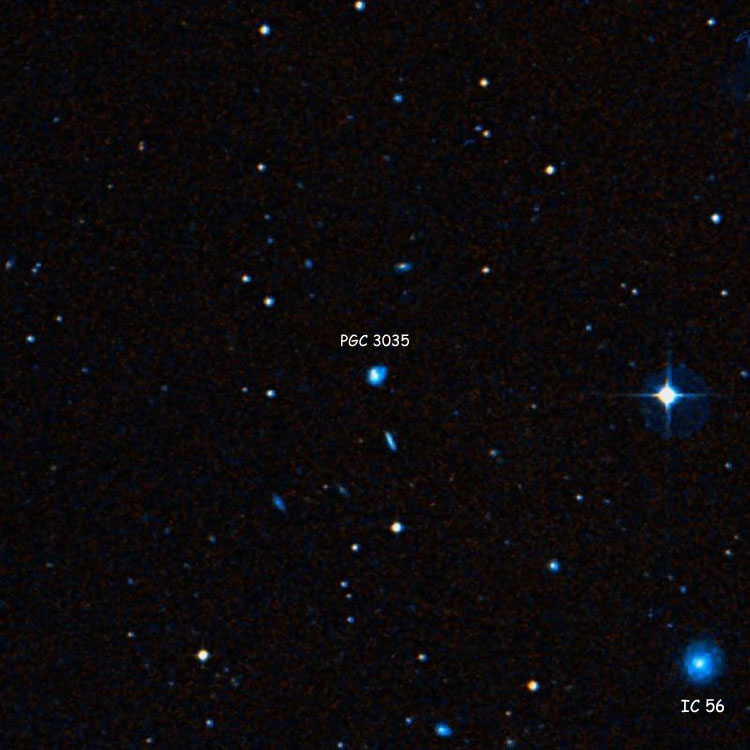
Above, a 12 arcmin wide DSS image centered on PGC 3505, also showing IC 56
Below, a 0.6 arcmin wide DSS image of the galaxy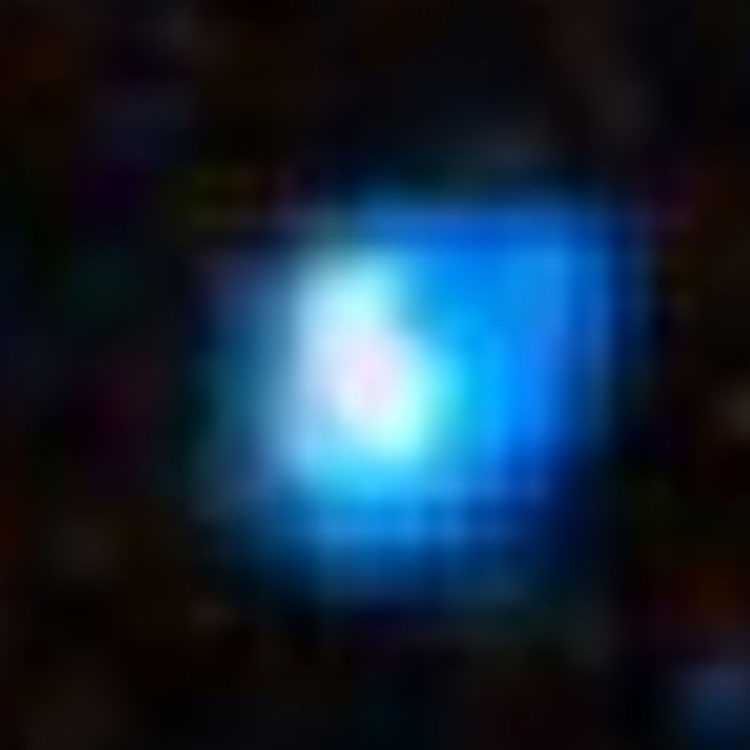
IC 57 (= PGC 3229)
Discovered (Dec 2, 1893) by Stephane Javelle
A magnitude 14.5 lenticular galaxy (type S0?) in Pisces (RA 00 54 48.5, Dec +11 50 29)
Historical Identification: Per Dreyer, IC 57 (Javelle 513, 1860 RA 00 47 31, NPD 78 55.4) is "faint, very small, round, a very little brighter middle, faint star close". The position precesses to RA 00 54 49.7, Dec +11 50 13, less than 0.4 arcmin southeast of the center of the galaxy listed above, just beyond its outline, and there is nothing else nearby so the identification is certain.
Physical Information: Based on a recessional velocity of 11425 km/sec, a straightforward calculation indicates that IC 57 is about 530 million light years away. However, for objects at such distances we should take into account the expansion of the Universe during the time it took their light to reach us. Doing that shows that the galaxy was about 510 million light years away at the time the light by which we see it was emitted, about 520 million years ago (the difference between the two numbers being due to the expansion of the intervening space during the light-travel time). Given that and its apparent size of 0.6 by 0.45 arcmin, the galaxy is about 90 thousand light years across.

Above, a 12 arcmin wide SDSS image centered on IC 57
Below, a 1 arcmin wide SDSS image of the galaxy
IC 58 (= PGC 3257)
Discovered (Aug 23, 1892) by Stephane Javelle
A magnitude 14.4 lenticular galaxy (type S0/a?) in Cetus (RA 00 55 02.4, Dec -13 40 41)
Historical Identification: Per Dreyer, IC 58 (Javelle 36, 1860 RA 00 48 02, NPD 104 26.5) is "faint, very small, round, mottled but not resolved". The position precesses to RA 00 55 01.8, Dec -13 40 54, only a quarter arcmin southwest of the center of the galaxy listed above, just off its southwestern rim, and there is nothing else nearby so the identification is certain.
Physical Information: Based on a recessional velocity of 6290 km/sec, IC 58 is about 290 million light years away. Given that and its apparent size of 0.7 by 0.4 arcmin, it is about 60 thousand light years across.

Above, a 12 arcmin wide DSS image centered on IC 58
Below, a 1 arcmin wide DSS image of the galaxy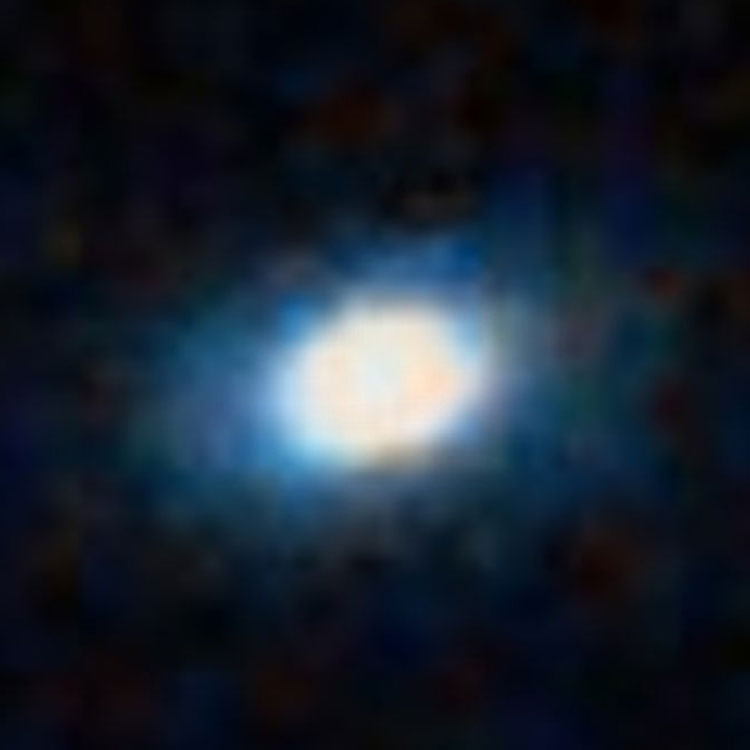
Below, a 0.75 arcmin wide PanSTARRS image of the galaxy
IC 59 (part of γ Cassiopeiae Nebula)
Discovered (Dec 30, 1893) by Max Wolf
Discovered (Feb 2, 1894) by Edward Barnard
Region photographed (Jan 17, 1890) by Isaac Roberts (but no nebulosity seen)
A reflection nebula in Cassiopeia, with its brightest part near RA 00 57 33.0, Dec +61 06 00
The center of the nebula based on modern photographs is near RA 00 57 10.0, Dec +61 08 30
Corwin's position is RA 00 57 14, Dec +61 10.8
Historical Identification: Per Dreyer, IC 59 (M. Wolf [(A.N.) 3214], Barnard, 1860 RA 00 49 00�, NPD 29 40) is "pretty faint, extremely large!, northeast of γ Cassiop(eia)". The position precesses to RA 00 57 27.1, Dec +61 05 31, close enough to the position of its brightest portion to make the identification certain.
Discovery Notes: A claim that Roberts discovered this nebula and IC 63 appears to rely on a photograph of the region near γ Cassiopeiae taken by Roberts on Jan 17, 1890; but that photograph shows no trace of any nebulosity near the star, and there is no mention of such nebulosity in any publication by Roberts. So Dreyer's omission of his name in the NGC entry is correct, and Wolf and Barnard deserve credit as the actual discoverers (their observations having been so close together that they were undoubtedly independent discoveries).
Discovery Notes (2): Barnard's date of discovery is usually given as Feb 6, 1894, but (per Corwin) in Lick Publications vol 11 Barnard discussed this nebulosity and IC 63 as observed on plates taken on Feb 2 and on Nov 7 and 8 of 1894, and in an 1894 Astronomy and Astro-Physics paper (S21 in the list of Historical Reference Papers) he includes a sketch of the nebulae as seen on photographs taken on Feb 2 and 6, 1894. Tradition assigns the discovery date of objects on photographic plates to the dates the plates were taken, not the dates on which they were examined (which in some cases, was months or years later), so Feb 2 is the discovery date. And in this case that date is especially appropriate, as Barnard's A&A-P paper includes a sketch of the region and states that before taking the exposure of Feb 6 he visually examined the region, and "It was with the utmost difficulty that I could see these two nebulae. They were excessively dilute and faint, and never would have been detected if the photographic plate had not revealed them." This means that he must have already seen them on the plate taken on Feb 2, so it was indeed the source of his discovery.
Physical Information: The nebula glows primarily by light scattered from nearby γ Cassiopeiae, so it is bluish, while the rest of the surrounding nebulosity is either dark due to obscuring dust or reddish due to hydrogen emissions excited by the star. The clouds of gas and dust in the region (which include IC 63) are being heated and blown away by the star, and will eventually disperse into unobservably faint and rarified features. γ Cas is a 15 solar-mass eruptive variable, about 70 thousand times brighter than the Sun, which is rotating so fast that it has a substantial equatorial bulge and has developed a "decretion" disk of material thrown off by its rapid rotation. It is probably nearing the end of its ten to fifteen million year lifespan. The star and associated nebulosity are about 600 light years away. At that distance, a one-degree wide view of the region spans about 10 light years; since the apparent size of the extended nebulosity in IC 59 is about 13 by 9 arcmin, it is just over 2 light years across.
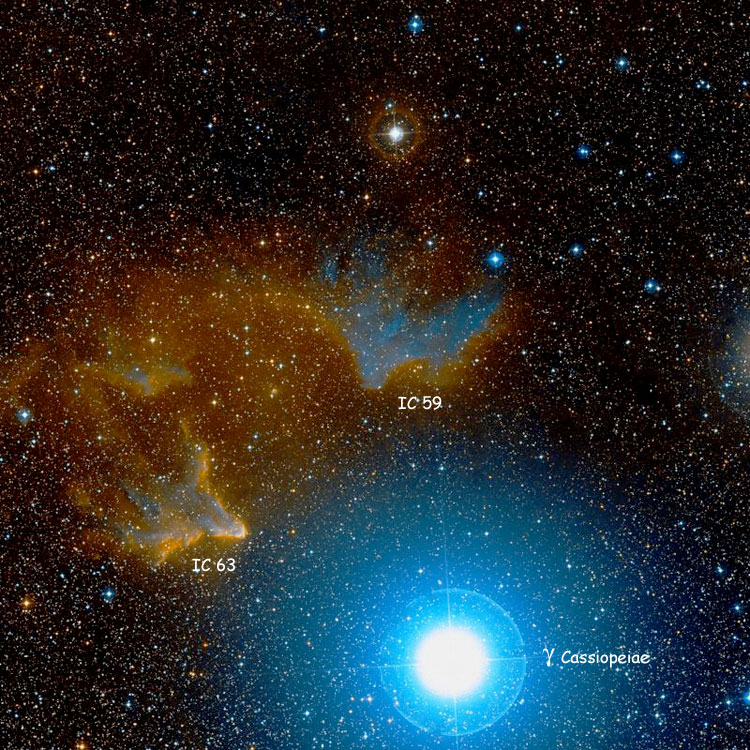
Above, a degree wide DSS image showing the region near IC 59 and 63
Below, a 15 arcmin wide DSS image centered on IC 59's brightest portion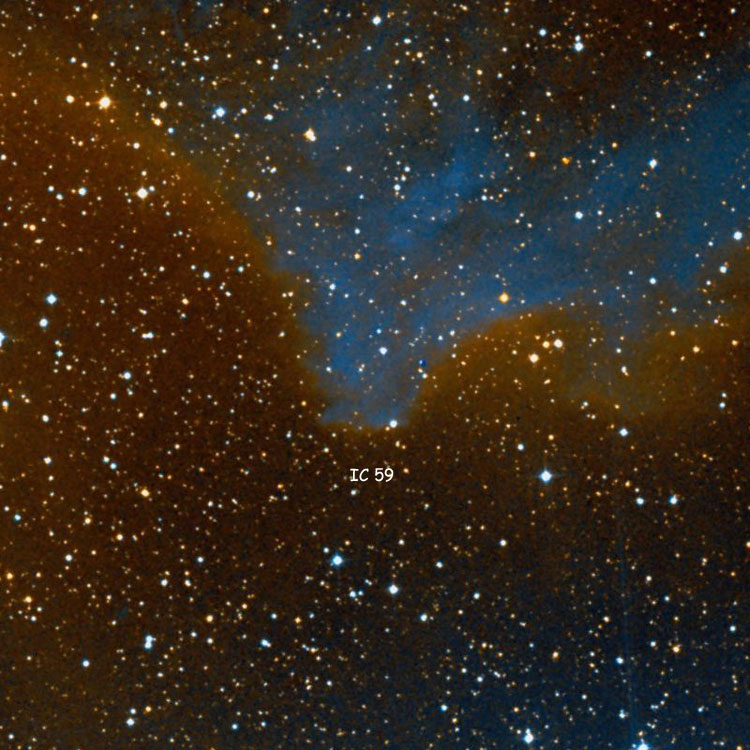
Below, a 15 arcmin wide DSS image centered on the modern definition of IC 59's center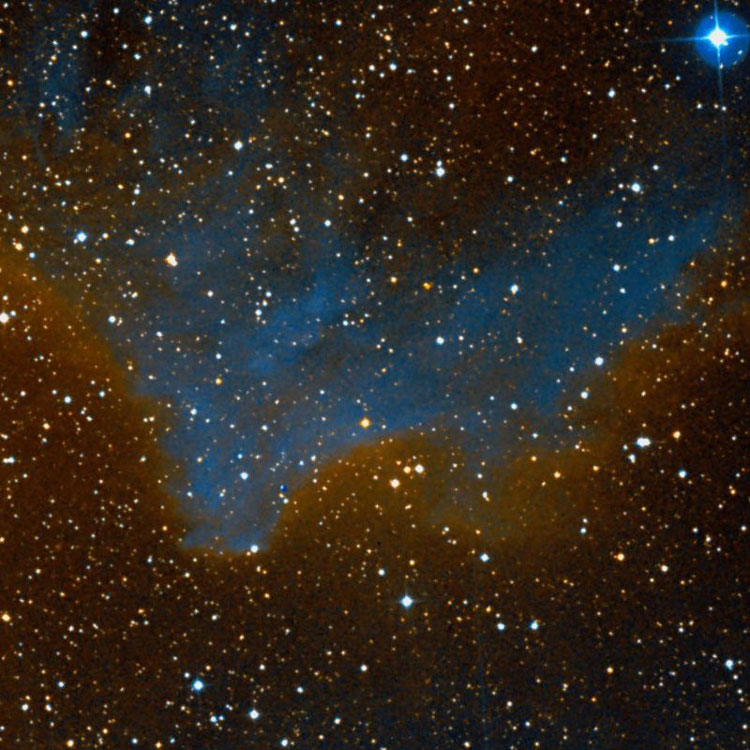
Below, Roberts' 1890 image of the region, showing that no nebulosity is visible
(North is at the bottom, so the nebulae would be down and to the right if they were visible)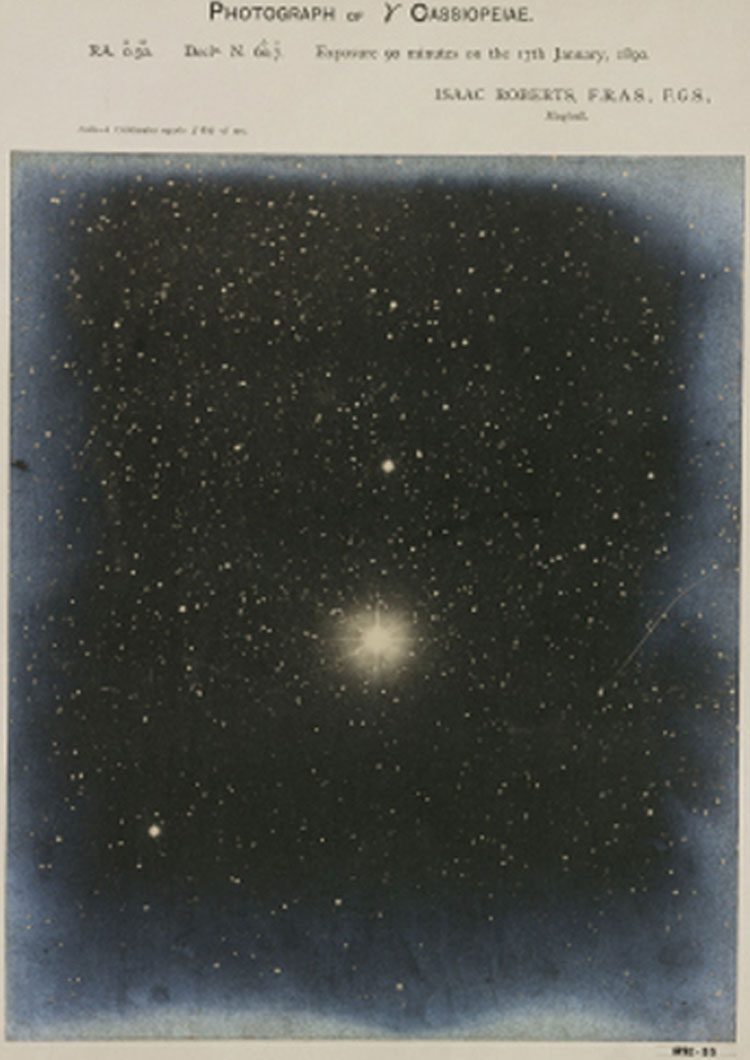
Below, Barnard's 1894 sketch of the region near Gamma Casseiopeia, showing IC 59 and 63
IC 60 (= PGC 3324)
Discovered (Aug 30, 1892) by Stephane Javelle
A magnitude 14.5 lenticular galaxy (type S0?) in Cetus (RA 00 56 04.2, Dec -13 21 29)
Historical Identification: Per Dreyer, IC 60 (Javelle 37, 1860 RA 00 49 05, NPD 104 07.7) is "faint, very small, round, small nucleus". The position precesses to RA 00 56 04.9, Dec -13 22 09, only 0.7 arcmin south southeast of the galaxy listed above, the description fits and there is nothing else nearby, so the identification is certain.
Physical Information: Based on a recessional velocity of 16805 km/sec, a straightforward calculation indicates that IC 60 is about 785 million light years away. However, for objects at such distances we should take into account the expansion of the Universe during the time it took their light to reach us. Doing that shows that the galaxy was about 735 million light years away at the time the light by which we see it was emitted, about 755 million years ago (the difference between the two numbers being due to the expansion of the intervening space during the light-travel time). Given that and its apparent size of about 0.45 by 0.3 arcmin (from the images below), the galaxy is about 95 thousand light years across.

Above, a 12 arcmin wide DSS image centered on IC 60
Below, a 0.8 arcmin wide DSS image of the galaxy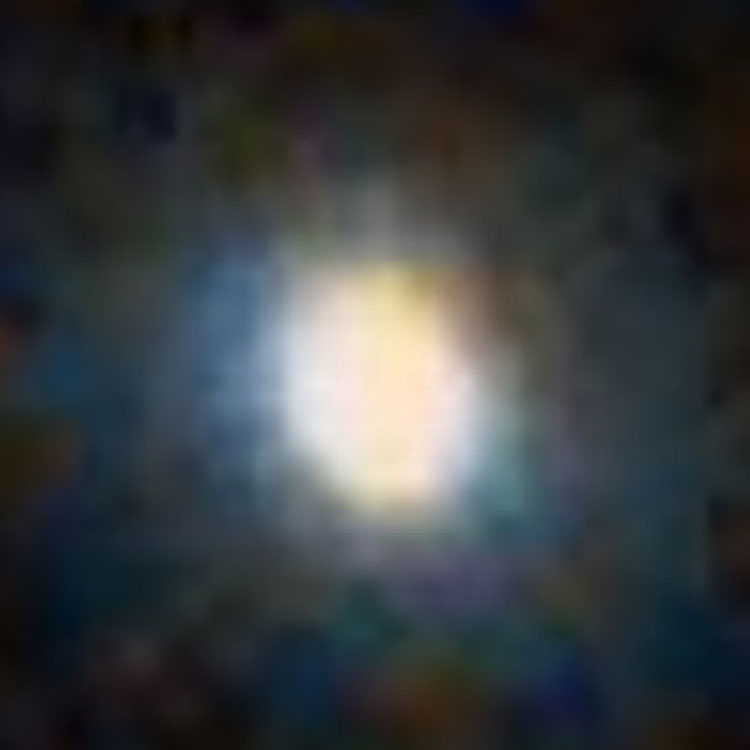
Below, a 0.8 arcmin wide PanSTARRS image of the galaxy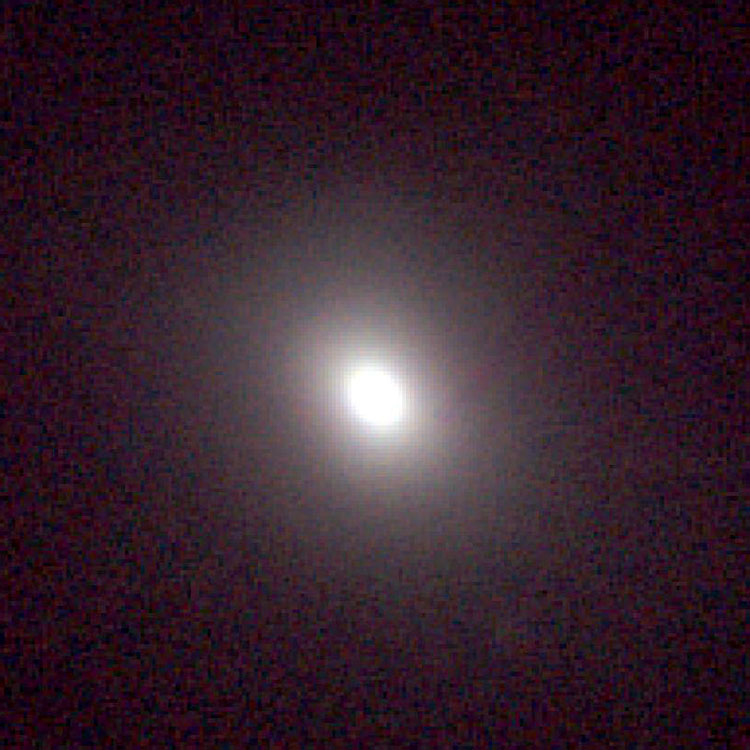
IC 61 (= PGC 3408)
Discovered (Nov 10, 1892) by Stephane Javelle
A magnitude 13.9 lenticular galaxy (type S0/a? pec) in Pisces (RA 00 57 07.2, Dec +07 30 26)
Historical Identification: Per Dreyer, IC 61 (Javelle 514, 1860 RA 00 49 50, NPD 83 15.4) is "pretty faint, very small, round, a very little brighter middle". The position precesses to RA 00 57 05.7, Dec +07 30 06, just off the southwestern rim of the galaxy listed above, the description fits and there is nothing else nearby, so the identification is certain.
Physical Information: Based on a recessional velocity of 11230 km/sec, a straightforward calculation indicates that IC 61 is about 525 million light years away. However, for objects at such distances we should take into account the expansion of the Universe during the time it took their light to reach us. Doing that shows that the galaxy was about 500 million light years away at the time the light by which we see it was emitted, about 510 million years ago (the difference between the two numbers being due to the expansion of the intervening space during the light-travel time). Given that and its apparent size of 1.05 by 0.9 arcmin, the galaxy is about 150 thousand light years across.
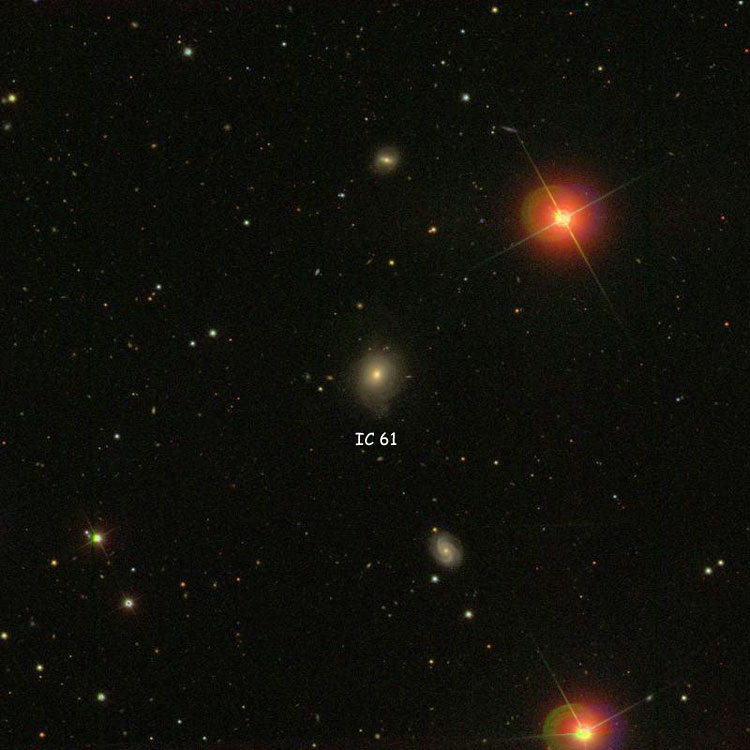
Above, a 12 arcmin wide SDSS image centered on IC 61
Below, a 1.4 arcmin wide SDSS image of the galaxy
PGC 212628
Not an IC object but listed here as a possible companion of IC 61
A magnitude 16(?) spiralgalaxy (type S?) in Pisces (RA 00 57 06.5, Dec +07 33 51)
Physical Information: LEDA B 16.9, K 12.6 NED .24 x .17 arcmin, 3K Vr 14913 km/sec, z 0.04974521369; probably a background object, as Vr is more than 3600 km/sec larger
PGC 3402
(= MCG +01-03-008)
Not an IC object but listed here as a possible companion of IC 61
A magnitude 15.5(?) spiral galaxy (type Sbc?) in Pisces (RA 00 57 02.7, Dec +07 27 36)
Physical Information: LEDA Sbc, B 16.1, K 11.9
NED .4 x .3 arcmin, 3K Vr 9668 km/sec, z 0.03225018978; probably a foreground galaxy, as Vr is nearly 1600 km/sec less
IC 62 (= PGC 3507)
Discovered (Dec 2, 1893) by Stephane Javelle
A magnitude 14.1 spiral galaxy (type Sbc?) in Pisces (RA 00 58 43.9, Dec +11 48 29)
Historical Identification: Per Dreyer, IC 62 (Javelle 515, 1860 RA 00 51 24, NPD 78 57.0) is "very faint, pretty large, diffuse". The position precesses to RA 00 58 43.3, Dec +11 48 26, right on the galaxy listed above, the description fits and there is nothing else nearby, so the identification is certain.
Physical Information: Based on a recessional velocity of 11590 km/sec, a straightforward calculation indicates that IC 62 is about 540 million light years away. However, for objects at such distances we should take into account the expansion of the Universe during the time it took their light to reach us. Doing that shows that the galaxy was about 515 million light years away at the time the light by which we see it was emitted, about 525 million years ago (the difference between the two numbers being due to the expansion of the intervening space during the light-travel time). Given that and its apparent size of 0.75 by 0.45 arcmin, the galaxy is about 110 thousand light years across.

Above, a 12 arcmin wide SDSS image centered on IC 62
Below, a 1 arcmin wide SDSS image of the galaxy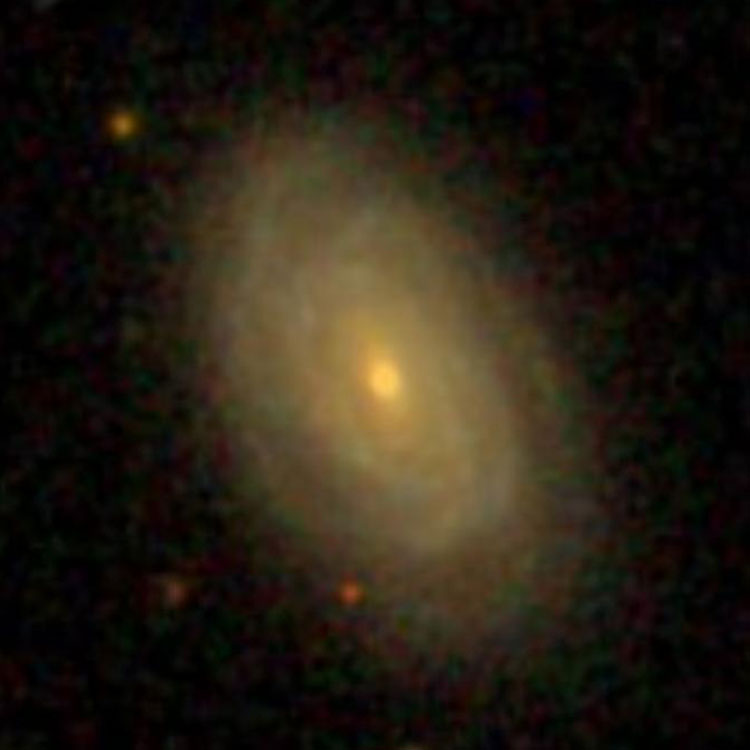
IC 63 (part of γ Cassiopeiae Nebula)
Discovered (Dec 30, 1893) by Max Wolf
Discovered (Feb 2, 1894) by Edward Barnard
Region photographed (Jan 17, 1890) by Isaac Roberts (but no nebulosity seen)
An emission nebula in Cassiopeia, with its brightest part near RA 00 59 03.0, Dec +60 53 40
The center of the nebula based on modern photographs is near RA 00 59 29.0, Dec +60 55 00
Historical Identification: Per Dreyer, IC 63 (Barnard, M. Wolf [(A.N.) 3214], 1860 RA 00 51 50�, NPD 29 55) is "pretty faint, extremely large!, connected with northwestern one", the northwestern one being IC 59. The position precesses to RA 01 00 20.3, Dec +60 50 22, several arcmin to the southeast of the nebula listed above, but close enough in comparison to its very lage size to make the identification certain.
Discovery Notes: A claim that Roberts discovered this nebula and IC 59 appears to rely on a photograph of the region near γ Cassiopeiae taken by Roberts on Jan 17, 1890; but that photograph shows no trace of any nebulosity near the star, and there is no mention of such nebulosity in any publication by Roberts (see IC 59 for a copy of the photograph in question). So Dreyer's omission of his name in the NGC entry is correct, and Wolf and Barnard deserve credit as the actual discoverers (their observations having been so close together that they were undoubtedly independent discoveries). Also see Discovery Notes (2) for IC 59 for a discussion of the appropriate discovery date for Barnard's observation.
Physical Information: For most of the details about the nebulosity in the region and the star lighting it up, see IC 59; since the apparent size of the extended nebulosity in IC 63 is about 10 by 10 arcmin, it is almost 2 light years across.

Above, a 1 degree wide DSS image of the region near IC 59 and IC 63
Below, a 15 arcmin wide DSS image centered on the brightest part of the nebula
Below, a 12 arcmin wide image of the overall nebula (equal to about 2 light years at its distance)
(Image credit & © Jim Misti, Misti Mountain Observatory; used by permission)
Corwin lists a possible companion (emission nebula; no ID?) at RA 01 00 00, Dec +61 05.5
IC 64 (= PGC 3550)
Discovered (Dec 5, 1893) by Stephane Javelle
A magnitude 14.0 lenticular galaxy (type (R)S0/a? pec?) in Pisces (RA 00 59 24.4, Dec +27 03 32)
Historical Identification: Per Dreyer, IC 64 (Javelle 516, 1860 RA 00 51 51, NPD 63 42.2) is "faint, small, round, gradually much brighter middle". The position precesses to RA 00 59 23.9, Dec +27 03 12, just off the southwest rim of the galaxy listed above, the description fits and there is nothing comparable nearby, so the identification is certain.
Physical Information: Based on a recessional velocity of 13770 km/sec, a straightforward calculation indicates that IC 64 is about 640 million light years away, in poor agreement with a single redshift-independent distance estimate of 475 million light years. However, for objects at such distances we should take into account the expansion of the Universe during the time it took their light to reach us. Doing that shows that the galaxy was about 610 million light years away at the time the light by which we see it was emitted, about 620 million years ago (the difference between the two numbers being due to the expansion of the intervening space during the light-travel time). Given that and its apparent size of 1.7 by 1.4 arcmin, the galaxy is about 300 thousand light years across, making it one of the largest galaxies known.

Above, a 12 arcmin wide SDSS image centered on IC 64
Below, a 2 arcmin wide SDSS image of the galaxy
PGC 3536
(= PGC 212636 = MCG +04-03-030)
Not an IC object but listed here as a probable companion of IC 64
A magnitude 14.5 galaxy (type ?) in Pisces (RA 00 59 03.6, Dec +27 02 33)
Physical Information: NED .6 x .6 arcmin, 3K Vr 14257 km/sec z 0.04755595
IC 65 (= PGC 3635)
Discovered (Sep 25, 1890) by Lewis Swift
A magnitude 12.9 spiral galaxy (type SAB(s)bc?) in Andromeda (RA 01 00 55.4, Dec +47 40 55)
Historical Identification: Per Dreyer, IC 65 (Swift list X (#4), 1860 RA 00 52 53, NPD 43 04.2) is "extremely faint, pretty large, much extended, bright stars to east and south". The position precesses to RA 01 00 53.1, Dec +47 41 08, on the western rim of the galaxy listed above, the description fits perfectly and there is nothing else nearby, so the identification is certain.
Physical Information: Based on a recessional velocity of 2615 km/sec, IC 65 is about 120 million light years away, in good agreement with redshift-independent distance estimates of 70 to 120 million light years. Given that and its apparent size of 4.1 by 0.95 arcmin, it is about 145 thousand light years across.

Above, a 12 arcmin wide DSS image centered on IC 65
Below, a 4.5 arcmin wide DSS image of the galaxy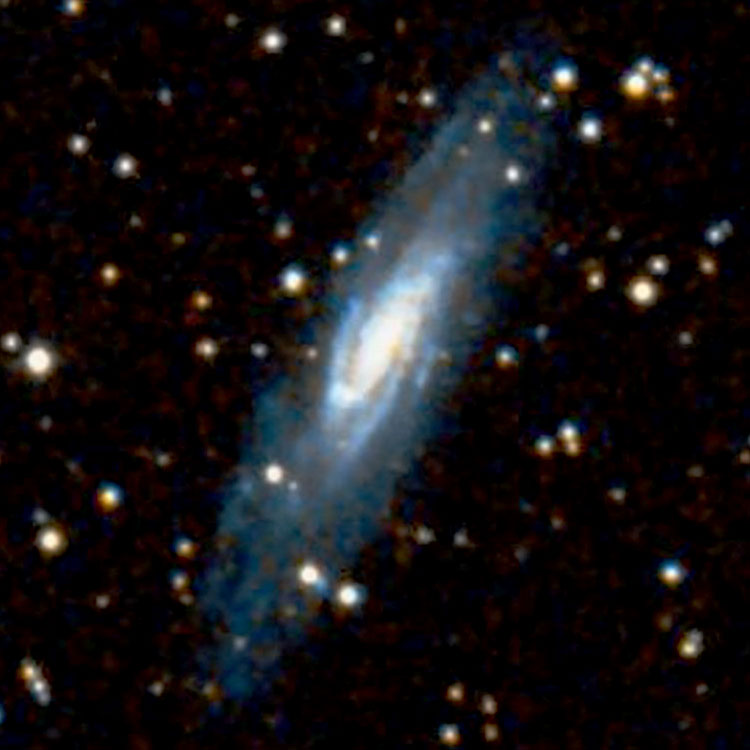
IC 66 (= PGC 3606)
Discovered (Nov 12, 1890) by Guillaume Bigourdan
A magnitude 14.1 spiral galaxy (type Sa?) in Pisces (RA 01 00 32.5, Dec +30 47 50)
Historical Identification: Per Dreyer, IC 66 (Bigourdan 108, 1860 RA 00 52 56, NPD 59 58) is "very faint, very small, irregular". The position precesses to RA 01 00 33.2, Dec +30 47 21, barely south of the southeastern rim of the galaxy listed above and there is nothing else nearby, so the identification is certain.
Physical Information: Based on a recessional velocity of 4825 km/sec, IC 66 is about 225 million light years away, in good agreement with redshift-independent distance estimates of 200 to 285 million light years. Given that and its apparent size of 0.85 by 0.35 arcmin, it is about 55 thousand light years across.
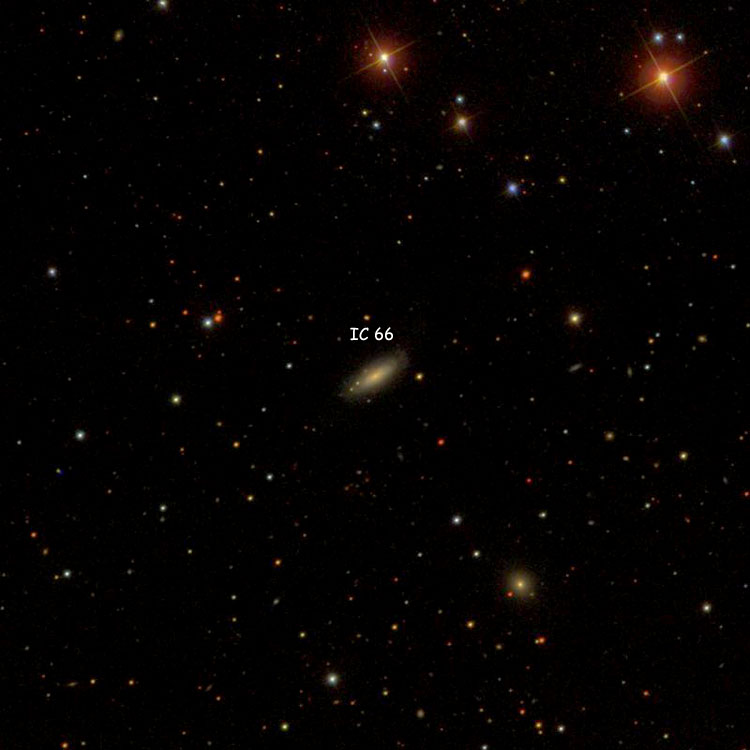
Above, a 12 arcmin wide SDSS image centered on IC 66
Below, a 1 arcmin wide SDSS image of the galaxy
PGC 1916053
Not an IC object but listed here as an apparent companion of IC 66
A magnitude 16(?) galaxy (type ?) in RA 01 00 21.7, Dec +30 44 30)
Physical Information: LEDA B 16.9, K 12.2; NED 3K Vr 15530 km/sec, z 0.051802627, so a much more distant background galaxy
IC 67
Recorded (Nov 21, 1889) by Guillaume Bigourdan
A nonexistent object in Cetus (RA 01 00 18.7, Dec -06 54 32)
Historical Identification: Per Dreyer, IC 67 (Bigourdan 109, 1860 RA 00 53 14, NPD 97 40) is "very faint, suspected". The position precesses to RA 01 00 18.4, Dec -06 54 39, but there is nothing there. Given Bigourdan's tendency to identify faint stars as nebulous objects and the fact that in this case he only "suspected" its existence, we would usually assume that he observed only a faint star or stars. To see which if any object can be connected with Bigourdan's 109, we refer to his original paper. It states that he observed the region three times. On the first instance (Nov 21, 1889) he "observed" the object but made no effort to determine its position; on the last instance he was unable to find it. So we have only one measurement of its position relative to a 9th magnitude comparison star listed as having (1900) RA 00 55 07.5, Dec -07 23 36. This precesses to J2000 RA 01 00 10.7, Dec -06 51 15, indicating that the comparison star was the 10th magnitude star at RA 01 00 11.1, Dec -06 51 00. Precessing this to the equinox of 1900 and adding Bigourdan's offsets for his #109, that object should be at (1900) RA 00 55 15.5, Dec -07 26 53, which precesses to J2000 RA 01 00 18.7, Dec -06 54 32 (whence the position listed above), but there is nothing anywhere near there that Bigourdan (or anyone else of his time) could have possibly seen. So it appears (as suggested by Corwin) that having been looking at a region full of faint nebulae, Bigourdan strained to see things where there was nothing to be seen (which would explain his inability to find the object on his final effort), and IC 67 is a nonexistent object.

Above, a 12 arcmin wide SDSS image centered on Bigourdan's position for IC 67, showing NGC 340
(Bigourdan's position being indicated by a box)
IC 68
Recorded (Nov 21, 1889) by Guillaume Bigourdan
A nonexistent object in Cetus (RA 01 00 22.5, Dec -06 56 18)
Historical Identification: Per Dreyer, IC 68 (Bigourdan 110, 1860 RA 00 53 18, NPD 97 42) is "very faint, suspected". The position precesses to RA 01 00 22.4, Dec -06 56 39, but as in the case of IC 67, there is nothing there. Following the same line of reasoning as for IC 67, which was observed on the same (first two) nights, using the same comparison star, we find that the position of Bigourdan's #110 should be (1900) RA 00 55 19.3, Dec -07 28 39, which precesses to J2000 RA 01 00 22.5, Dec -06 56 18 (whence the position above), and as in the case of IC 67 we find that there is absolutely nothing anywhere near there that Bigourdan could possibly have seen. So (again, following Corwin's suggestion) as in the case of IC 67, IC 68 must be the result of trying to see more than could be seen, and is a nonexistent object.
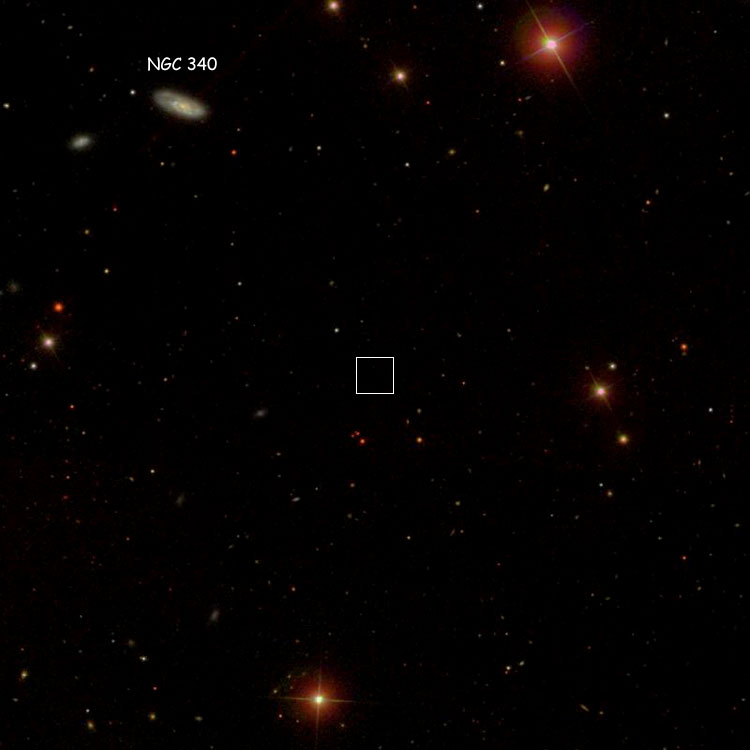
Above, a 12 arcmin wide SDSS image centered on Bigourdan's position for IC 68, showing NGC 340
(Bigourdan's position being indicated by a box)
IC 69 (= PGC 3666 = PGC 1929122)
Discovered (Nov 8, 1866) by Truman Safford
A magnitude 13.7 spiral galaxy (type SABbc? pec) in Pisces (RA 01 01 23.7, Dec +31 02 27)
Historical Identification: Per Dreyer, IC 69 (Safford 66, 1860 RA 00 53 48, NPD 59 40.9) is "faint, irregular figure, a little brighter middle". The position precesses to RA 01 01 25.9, Dec +31 04 24, about 2 arcmin north northeast of the galaxy listed above, but the description fits and there is nothing else nearby, so the identification is certain.
Physical Information: Based on a recessional velocity of 5015 km/sec, IC 69 is about 235 million light years away, in good agreement with redshift-independent distance estimates of 230 to 235 million light years. Given that and its apparent size of 0.85 by 0.7 arcmin, it is about 55 thousand light years across.
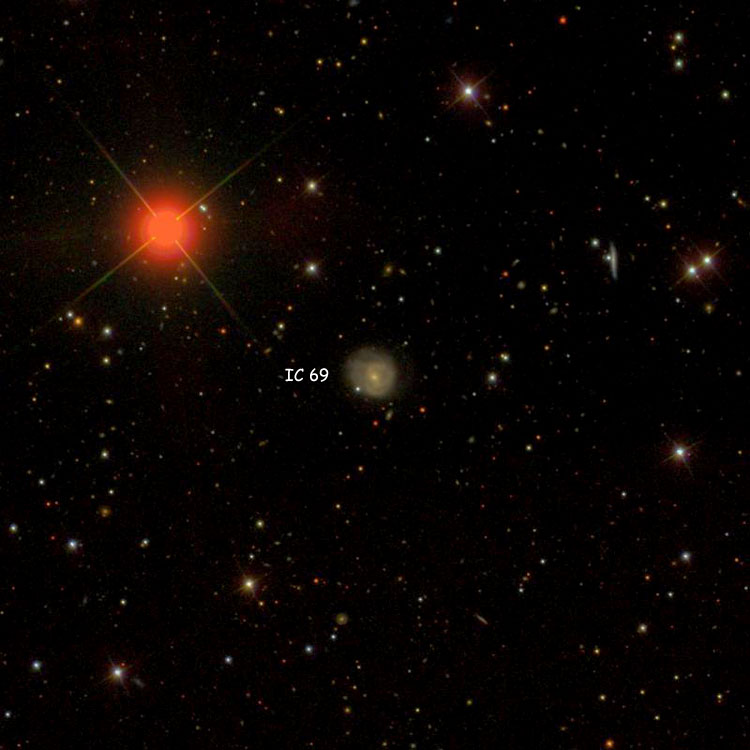
Above, a 12 arcmin wide SDSS image centered on IC 69
Below, a 1 arcmin wide SDSS image of the galaxy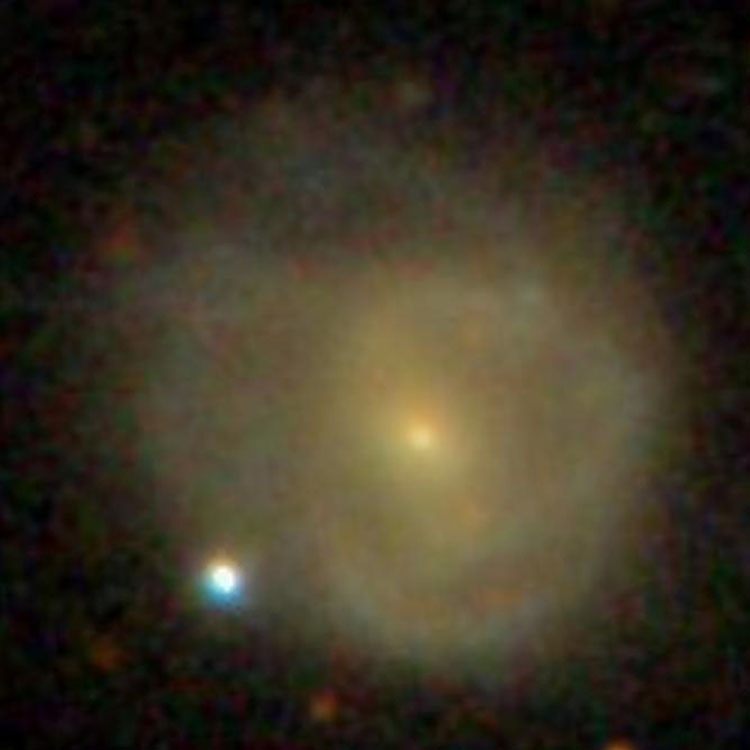
IC 70 (= PGC 173286)
Discovered (Nov 7, 1891) by Stephane Javelle
A magnitude 16.3 lenticular galaxy (type SAB0?) in Cetus (RA 01 01 04.0, Dec +00 03 03)
Historical Identification: Per Dreyer, IC 70 (Javelle 38, 1860 RA 00 53 54, NPD 90 42.4) is "very faint, very small, a little brighter middle". The position precesses to RA 01 01 04.0, Dec +00 02 55, less than 0.1 arcmin from the southern rim of the very small galaxy listed above, and 1.3 arcmin from the nearest other candidate, which would be a very uncharacteristic error for Javelle; so the identification is certain.
Physical Information: Based on a recessional velocity of 19005 km/sec, a straightforward calculation indicates that IC 70 is about 885 million light years away. However, for objects at such distances we should take into account the expansion of the Universe during the time it took their light to reach us. Doing that shows that the galaxy was about 820 million light years away at the time the light by which we see it was emitted, about 845 million years ago (the difference between the two numbers being due to the expansion of the intervening space during the light-travel time). Given that and its apparent size of 0.3 by 0.15 arcmin, the galaxy is about 70 thousand light years across
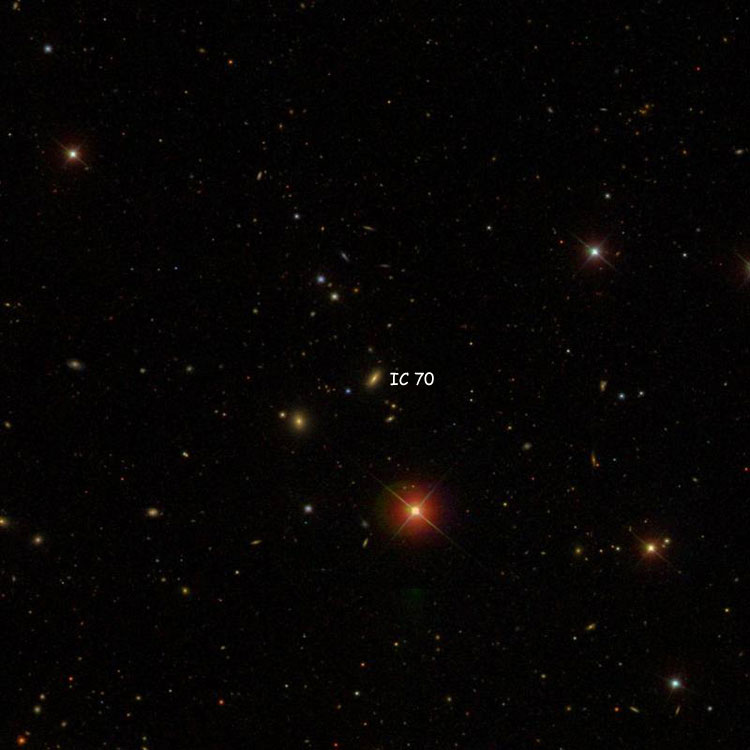
Above, a 12 arcmin wide SDSS image centered on IC 70
Below, a 0.4 arcmin wide SDSS image of the galaxy
PGC 1155530
Not an IC object but listed here as a probable companion of IC 70
A magnitude 16(?) elliptical galaxy (type E?) in Cetus (RA 01 01 08.8, Dec +00 02 21)
Physical Information: LEDA B 16.8, I 15.0; NED RIDE1 229 Mpc, .4 x .32 arcmin, 3K Vr 19777 km/sec, z 0.0659675
IC 71 (not = NGC 347)
Recorded (Nov 21, 1889) by Guillaume Bigourdan
Probably a nonexistent object in Cetus RA 01 01 18.4, Dec -06 47 15
but perhaps a magnitude 14.3 star at RA 01 01 19.3, Dec -06 46 01
Historical Identification: Per Dreyer, IC 71 (Bigourdan 111, 1860 RA 00 54 14, NPD 97 32) is "very faint, suspected". The position precesses to RA 01 01 18.4, Dec -06 46 42, but there is nothing there save for a 14th magnitude star about 0.7 arcmin to the north northeast. Given Bigourdan's penchant for seeing faint stars as nebulous objects and the fact that he only "suspected" the object to be nebulous, we have to refer to his original observations to confirm or rule out the possibility that the star in question is what he observed. Bigourdan lists (1900) RA 00 56 31.82, Dec -07 20 19.8 as the position of his 8th magnitude comparison star, which precesses to J2000 RA 01 01 35.0, Dec -06 48 01. This shows that the comparison star was 7th magnitude HD 6031, which has a J2000 position of RA 01 01 34.3, Dec -06 47 58 (just a little off the position used by Bigourdan). Precessing that to the equinox of 1900 and adding Bigourdan's offsets for his #111 shows that it should be at (1900) RA 00 56 15.2, Dec -07 19 34, which precesses to J2000 RA 01 01 18.4, Dec -06 47 15 (whence the first position above), about 1.3 arcmin south southwest of the star in question; and since Bigourdan's positions were usually better than that, it appears that as in the case of a number of objects observed on the night in question (including IC 67, IC 68 and IC 72), he simply strained to see more than was there to see, and IC 71 is probably a nonexistent object. However, Corwin points out that about 9 years later Bigourdan observed the area again, and stated that there was a star about 5 arcmin to the west of (HD 6031) at a position angle of about 295�, and although he disavowed the possibility that it could be his #111, the position is about 1.3 arcmin west southwest of the star, close enough to the earlier position for Bigourdan #111 that the star could be what Bigourdan observed. So as shown at the start of this entry IC 71 could be a nonexistent object or it could be the nearby star, and there is no way to know which is the correct solution. (As pointed out by Thomson, LEDA misidentifies IC 71 as a duplicate of NGC 347. As shown by the position of that galaxy in the image below, that is clearly wrong. Hence the warning in the title for this entry.)

Above, a 12 arcmin wide SDSS image centered on Bigourdan's position for IC 71
(An empty box shows Bigourdan's position, and the nearby star is also shown in a box)
Also shown are NGC 345 and 347
IC 72
Recorded (Nov 21, 1889) by Guillaume Bigourdan
Probably a nonexistent object in Cetus (RA 01 01 32.5, Dec -06 46 01)
but perhaps a magnitude 15.1 star at RA 01 01 34.8, Dec -06 46 40
Historical Identification: Per Dreyer, IC 72 (Bigourdan 112, 1860 RA 00 54 28, NPD 97 31) is "a nebula; 7th magnitude star 2 arcmin to southeast". The position precesses to RA 01 01 32.4, Dec -06 45 43, about 2.3 arcmin north northwest of 7th magnitude HD 6031, which is consistent with the description, but there is nothing there. As in the case of three other objects (IC 67, IC 68 and IC 71) recorded by Bigourdan on the same night, this probably represents a nonexistent object, but the only way to be sure is to refer to Bigourdan's original measurements (given the often negligible change in the results, such an exercise may seem pointless, but sometimes round-off errors between the original papers and the NGC positions, or errors in historical estimates of the position of comparison stars cause noticeable differences between the NGC and actual positions). As in the case of IC 71, the comparison star is HD 6031, whose modern position precesses to (1900) RA 00 56 31.1, Dec -07 20 16. Adding the offsets for Bigourdan's #112 to this yields a position for that object of (1900) RA 00 56 29.3, Dec -07 18 19, which precesses to J2000 RA 01 01 32.5, Dec -06 46 01 (whence the position listed above), about 2.0 arcmin north northwest of HD 6031 (essentially the same result obtained directly from the NGC). There is, as suggested by Corwin, a slight chance that the 15th magnitude star 1.2 arcmin north northeast of HD 6031 is what Bigourdan observed, but given the nearly factor of two difference in the distance to HD 6031 and the noticeable difference in the specified direction, it is unlikely that Bigourdan recorded that star, and IC 72 is probably, like Bigourdan's #109, 110 and 111, a nonexistent object.

Above, a 12 arcmin wide SDSS image centered on Bigourdan's position for IC 72
(An empty box shows Bigourdan's position, and the nearby star is also shown in a box)
Also shown are NGC 347 and 349
PGC 1028378
Not an IC object but listed here as an apparent "companion" of IC 72
A magnitude 14.5(?) spiral galaxy (type (R)SBa? (R)SB0/a? pec) in Cetus (RA 01 01 29.1, Dec -06 48 40)
An Odd "Companion": Since IC 72 is either lost/nonexistent or merely a star, any galaxy listed as a "companion" cannot possibly be one; so ? is listed as such for IC 72 only because it would be if IC 72 was another galaxy.
Physical Information: LEDA B 15.25; NED .69 x .52 arcmin, 3K Vr 5257 km/sec
IC 73 (= PGC 3842)
Discovered (Aug 20, 1892) by Stephane Javelle
A magnitude 14.6 spiral galaxy (type SABbc?) in Pisces (RA 01 04 53.1, Dec +04 46 02)
Historical Identification: Per Dreyer, IC 73 (Javelle 39, 1860 RA 00 57 40, NPD 85 58.7) is "very faint, pretty large, diffuse". The position precesses to 01 04 54.1, Dec +04 46 25, only 0.5 arcmin northeast of the galaxy listed above, the description fits and there is nothing else nearby, so the identification is certain.
Physical Information: Based on a recessional velocity of 6275 km/sec, IC 73 is about 290 million light years away. Given that and its apparent size of 0.55 by 0.4 arcmin, it is about 45 thousand light years across.

Above, a 12 arcmin wide SDSS image centered on IC 73
Below, a 0.8 arcmin wide SDSS image of the galaxy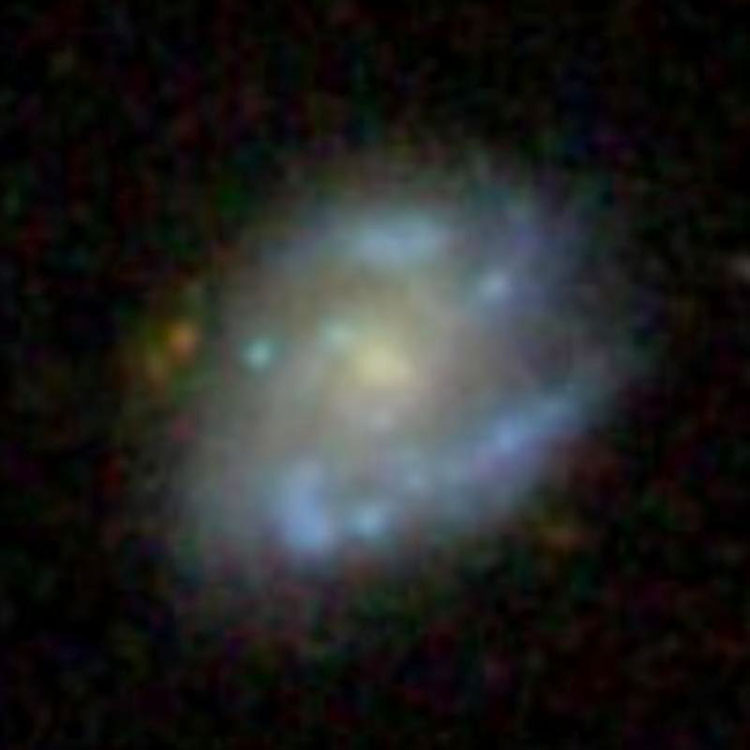
IC 74 (= PGC 3897)
Discovered (Aug 19, 1892) by Stephane Javelle
A magnitude 14.8 lenticular galaxy (type E/S0(r)?) in Pisces (RA 01 05 56.0, Dec +04 05 24)
Historical Identification: Per Dreyer, IC 74 (Javelle 40, 1860 RA 00 58 42, NPD 86 38.7) is "very faint, small, stellar". The position precesses to RA 01 05 55.6, Dec +04 06 21, just under an arcmin north of the galaxy listed above, the description fits and there is nothing else nearby, so the identification is certain.
Physical Information: Based on a recessional velocity of 5015 km/sec, IC 74 is about 235 million light years away. Given that and its apparent size of 0.55 by 0.45 arcmin, it is about 35 thousand light years across.
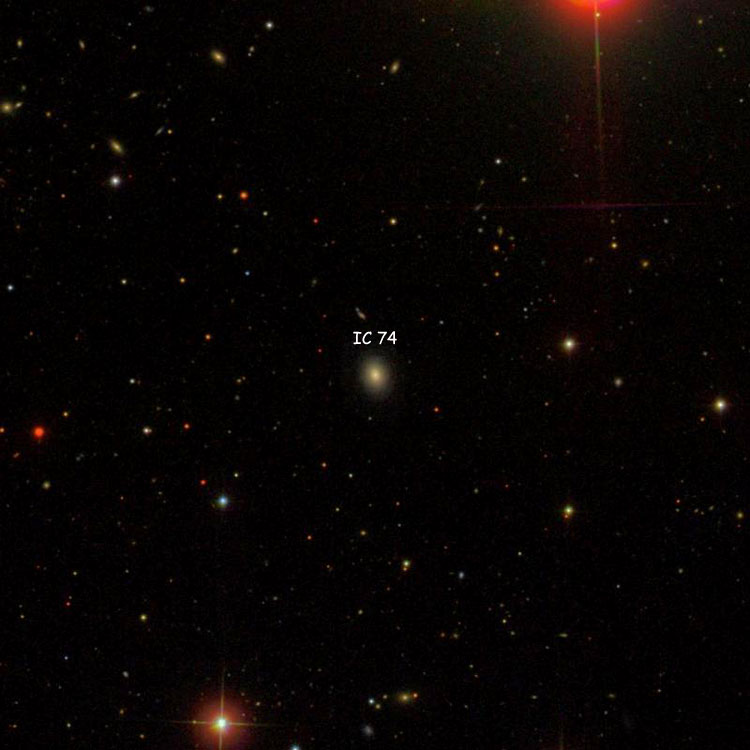
Above, a 12 arcmin wide SDSS image centered on IC 74
Below, a 0.8 arcmin wide SDSS image of the galaxy
IC 75 (= PGC 3959)
Discovered (Oct 17, 1892) by Stephane Javelle
A magnitude 13.9 spiral galaxy (type (R)S(rs)ab? pec) in Pisces (RA 01 07 11.6, Dec +10 50 13)
Historical Identification: Per Dreyer, IC 75 (Javelle 517, 1860 RA 00 59 51, NPD 79 55.0) is "very faint, very small, diffuse, a very little brighter middle". The position precesses to RA 01 07 10.7, Dec +10 49 59, within the southwestern outline of the galaxy listed above, the description fits and there is nothing else nearby, so the identification is certain.
Physical Information: Based on a recessional velocity of 12325 km/sec, a straightforward calculation indicates that IC 75 is about 575 million light years away. However, for objects at such distances we should take into account the expansion of the Universe during the time it took their light to reach us. Doing that shows that the galaxy was about 545 million light years away at the time the light by which we see it was emitted, about 560 million years ago (the difference between the two numbers being due to the expansion of the intervening space during the light-travel time). Given that and its apparent size of 1.4 by 1.1 arcmin (counting its outermost partial ring), the galaxy is about 220 thousand light years across; the 0.75 by 0.55 brighter region containing only the core and the central pair of rings spans about 120 thousand light years.
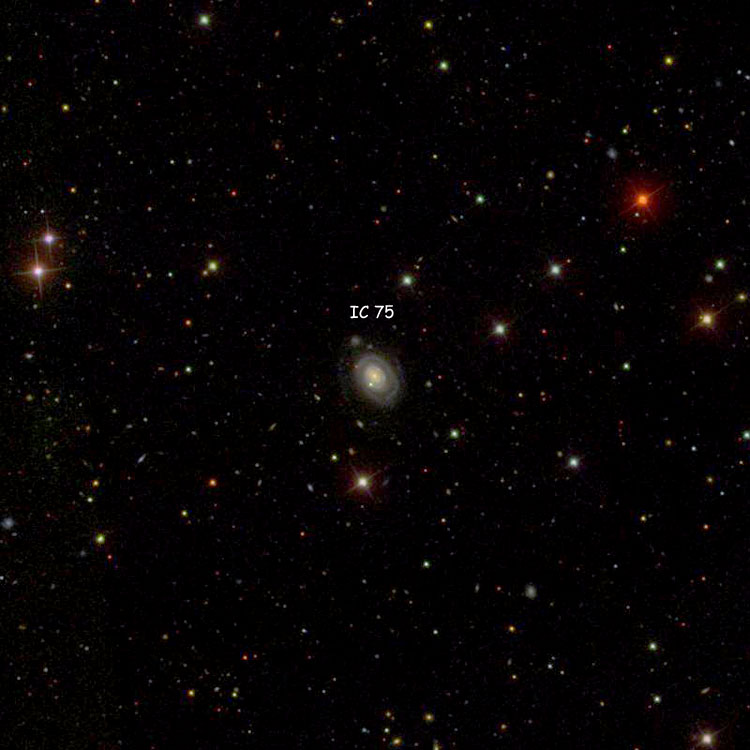
Above, a 12 arcmin wide SDSS image centered on IC 75
Below, a 1.6 arcmin wide SDSS image of the galaxy and its outer arms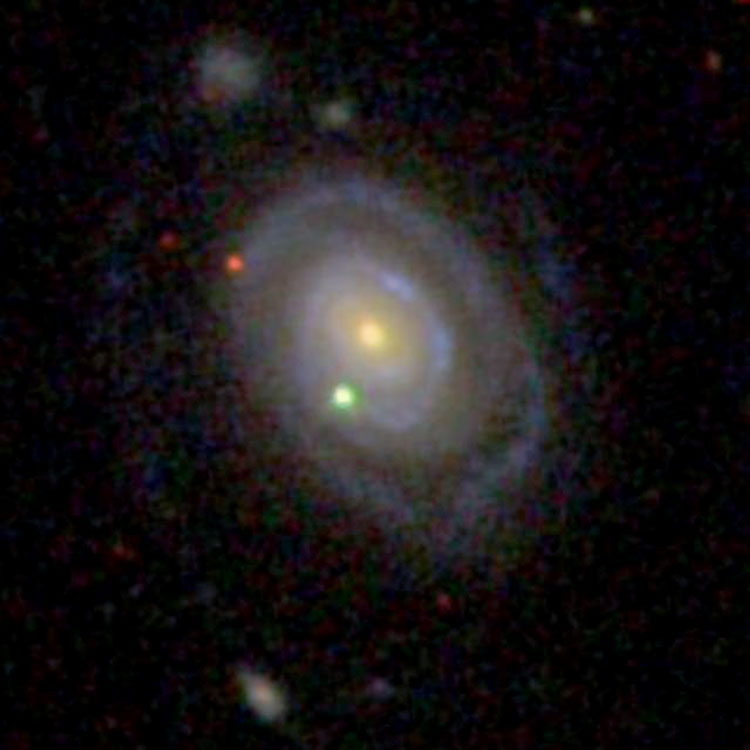
Below, a 1 arcmin wide SDSS image of the central portion of the galaxy
IC 76 (= PGC 4035 = PGC 143948)
Discovered (Dec 14, 1892) by Stephane Javelle
A magnitude 15.6 lenticular galaxy (type S0/a?) in Cetus (RA 01 08 11.7, Dec -04 33 16)
Historical Identification: Per Dreyer, IC 76 (Javelle 518, 1860 RA 01 01 06, NPD 95 18.3) is "faint, very small, round, a little brighter middle". The position precesses to RA 01 08 11.8, Dec -04 33 23, right on the galaxy listed above, the description fits and there is nothing else nearby, so the identification is certain.
Physical Information: Based on a recessional velocity of 7825 km/sec, a straightforward calculation indicates that IC 76 is about 365 million light years away. However, for objects at such distances we should take into account the expansion of the Universe during the time it took their light to reach us. Doing that shows that the galaxy was about 345 million light years away at the time the light by which we see it was emitted, about 350 million years ago (the difference between the two numbers being due to the expansion of the intervening space during the light-travel time). Given that and its apparent size of 0.7 by 0.3 arcmin, it is about 70 thousand light years across.

Above, a 12 arcmin wide SDSS image centered on IC 76
Below, a 0.9 arcmin wide SDSS image of the galaxy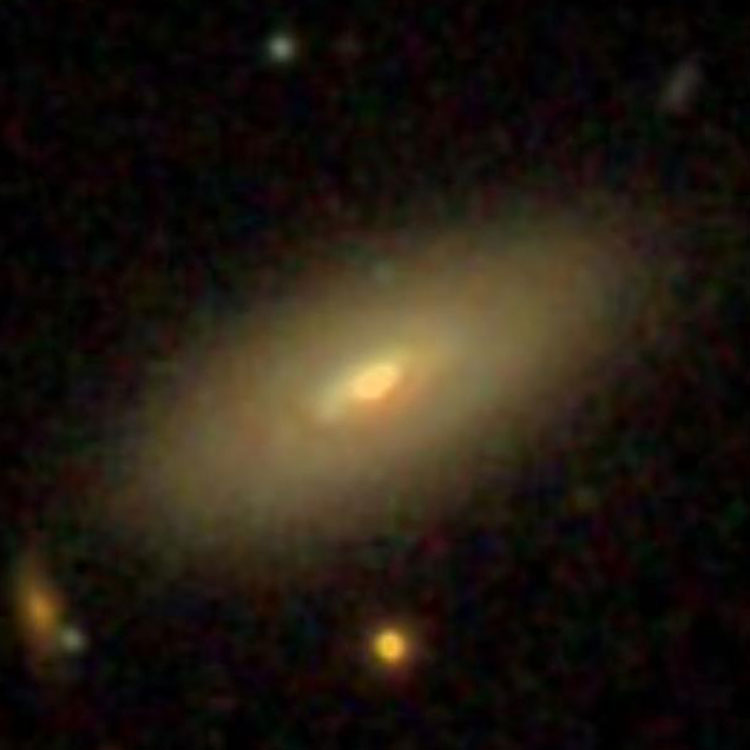
PGC 3080264
Not an IC object but listed here as an apparent companion of IC 76
A magnitude 16(?) spiral galaxy (type S?) in Cetus (RA 01 08 16.8, Dec -04 34 23)
Physical Information: LEDA 16.5, I 15.2; NED .38 x .22 arcmin, 3K Vr 6795 km/sec
IC 77 (= PGC 73653)
Discovered (Aug 31, 1892) by Stephane Javelle
A magnitude 14.9 lenticular galaxy (type S0?) in Cetus (RA 01 08 43.7, Dec -15 25 15)
Historical Identification: Per Dreyer, IC 77 (Javelle 41, 1860 RA 01 01 48, NPD 106 10.2) is "very faint, small, irregular, brighter middle". The position precesses to RA 01 08 43.4, Dec -15 25 19, on the southwestern corner of the galaxy listed above and there is nothing comparable nearby, so the identification is certain. Despite that, it is common for catalogs to misidentify IC 80 as IC 77, so the best way to ensure that you are reading about IC 77 is to use its PGC designation. (Per Corwin, the reason for the confusion is an error in the Morphological Catalog of Galaxies (MCG), a Russian catalog of nearly 31 thousand galaxies compiled between 1962 and 1974.)
Warning About Misidentifications In This Region: The confusion caused by the misidentification of IC 80 in the MCG has carried over to a number of objects in this region; so the correctly labeled images below will differ from the multitude of incorrectly labeled images of the region.
Physical Information: Based on a recessional velocity of 17510 km/sec, a straightforward calculation indicates that IC 77 is about 815 million light years away. However, for objects at such distances we should take into account the expansion of the Universe during the time it took their light to reach us. Doing that shows that the galaxy was about 760 million light years away at the time the light by which we see it was emitted, about 785 million years ago (the difference between the two numbers being due to the expansion of the intervening space during the light-travel time). Given that and its apparent size of 0.35 by 0.3 arcmin, the galaxy is about 75 thousand light years across.
Like many of the other galaxies in the region, IC 77 is generally considered part of the rich cluster, Abell 151. However, recessional velocities indicate that Abell 151 consists of a group of foreground galaxies, which should perhaps be considered "true" Abell 151 members, and a group of more distant galaxies at about the same distance as nearby Abell 166, which should probably be thought of as outlying members of that cluster. IC 77 is one of the galaxies at the larger distance, so although usually listed as part of Abell 151, it is probably actually part of Abell 166.
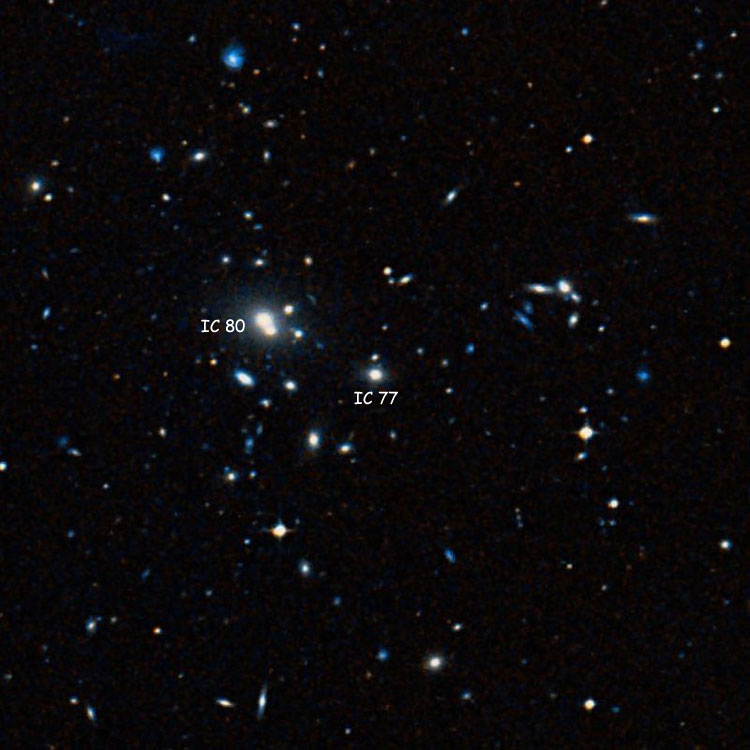
Above, a 12 arcmin wide DSS image centered on IC 77, also showing IC 80
Below, a 5 arcmin wide DSS image centered on IC 77, to allow for labeling of its neighbors
(including PGC 4070, (4071 + 4072 = IC 80), 4081, 73652, 73654, 73656, 73658, and 73659)
Below, a 0.5 arcmin wide DSS image of the galaxy
IC 78 (= PGC 4079)
Discovered (Aug 30, 1892) by Stephane Javelle
A magnitude 13.5 spiral galaxy (type SA(rs)a? pec) in Cetus (RA 01 08 47.7, Dec -15 50 43)
Historical Identification: Per Dreyer, IC 78 (Javelle 42, 1860 RA 01 01 52, NPD 106 35.4) is "faint, small, a little brighter middle, mottled but not resolved". The position precesses to RA 01 08 47.0, Dec -15 50 31, right on the galaxy listed above and there is nothing comparable nearby, so the identification is certain.
Physical Information: Based on a recessional velocity of 11765 km/sec, a straightforward calculation indicates that IC 78 is about 550 million light years away, in reasonable agreement with redshift-independent distance estimates of 365 to 530 million light years. However, for objects at such distances we should take into account the expansion of the Universe during the time it took their light to reach us. Doing that shows that the galaxy was about 525 million light years away (in slightly better agreement with redshift-independent distance estimates) at the time the light by which we see it was emitted, about 535 million years ago (the difference between the two numbers being due to the expansion of the intervening space during the light-travel time). Given that and its apparent size of 1.9 by 0.8 arcmin, the galaxy is about 290 thousand light years across, or about twice the size and probably ten times the mass of our Milky Way galaxy. Classified as a Seyfert galaxy (type Sy2). As noted in the entry for IC 77, galaxies which appear to be in Abell 151 probably consist of two groups at different distances, a nearer group which might be called the "true" Abell 151, and a more distant group which probably consists of outlying members of Abell 166; but since it is in the nearer group, IC 78 is in Abell 151 no matter how that cluster is divided.

Above, a 12 arcmin wide DSS image centered on IC 78, showing part of IC 79 at the very bottom
Below, a 2 arcmin wide DSS image of the galaxy
PGC 73648
Not an IC object but listed here as a possible companion of IC 78
A magnitude 16(?) lenticular galaxy (type S0?) in Cetus (RA 01 08 40.1, Dec -15 51 17)
Physical Information: LEDA S0, B 16.7, I 14.4; NED RIDE1 168 Mpc, S0, .45 x .27 arcmin, 3K Vr 12068 km/sec, z 0.040254319
IC 79 (= PGC 4082)
Discovered (Aug 30, 1892) by Stephane Javelle
A magnitude 14.2 lenticular galaxy (type E/SA0?) in Cetus (RA 01 08 49.7, Dec -15 56 56)
Historical Identification: Per Dreyer, IC 79 (Javelle 43, 1860 RA 01 01 54, NPD 106 41.7) is "round, small, brighter middle and nucleus equal to 14th magnitude star". The position precesses to RA 01 08 48.9, Dec -15 56 49, barely off the western rim of the galaxy listed above, the description fits and there is nothing comparable nearby, so the identification is certain.
Physical Information: Based on a recessional velocity of 12595 km/sec, a straightforward calculation indicates that IC 79 is about 585 million light years away, in reasonable agreement with redshift-independent distance estimates of 595 to 810 million light years. However, for objects at such distances we should take into account the expansion of the Universe during the time it took their light to reach us. Doing that shows that the galaxy was about 560 million light years away (in slightly poorer agreement with redshift-independent distance estimates) at the time the light by which we see it was emitted, about 570 million years ago (the difference between the two numbers being due to the expansion of the intervening space during the light-travel time). Given that and its apparent size of 0.4 by 0.35 arcmin, the galaxy is about 65 thousand light years across. Like IC 78 (which see), part of Abell 151 no matter how that cluster is defined.

Above, a 12 arcmin wide DSS image centered on IC 79, also showing IC 82 and part of IC 78
Below, a 0.7 arcmin wide DSS image of the galaxy
IC 80 (= PGC 4071 + PGC 4072 (= PGC 138321); the pair = PGC 3325365)
Discovered (Aug 31, 1892) by Stephane Javelle
PGC 4071 is a magnitude 12.9 lenticular galaxy (type E/S0?) in Cetus (RA 01 08 51.1, Dec -15 24 23)
PGC 4072 is a magnitude 14(?) lenticular galaxy (type E/S0?) at RA 01 08 50.7, Dec -15 24 32
Historical Identification: Per Dreyer, IC 80 (Javelle 44, 1860 RA 01 01 56, NPD 106 09.2) is "very faint, small, round, gradually brighter middle". The position precesses to RA 01 08 51.4, Dec -15 24 19, right on the brighter member of the pair and there is nothing comparable nearby, so the identification is certain. Despite that, it is common for catalogs to misidentify IC 80 as IC 77, and PGC 4070 as IC 80, so the best way to ensure that you are reading about IC 80 is to use its PGC designations. (Per Corwin, the reason for the confusion is an error in the Morphological Catalog of Galaxies (MCG), a Russian catalog of nearly 31 thousand galaxies compiled between 1962 and 1974.)
Warning About Misidentifications In This Region: The confusion caused by the misidentification of IC 80 in the MCG has carried over to a number of objects in this region; so the correctly labeled images below will differ from the multitude of incorrectly labeled images of the region.
Physical Information: PGC 4071 has a recessional velocity of 15775 km/sec, while PGC 4072 has a recessional velocity of 15910 km/sec. Their similar redshifts imply that the galaxies are probably a physical pair, and certainly at about the same distance from us. Given their average recessional velocity of 15845 km/sec, a straightforward calculation puts them about 740 million light years away. However, for objects at such distances we should take into account the expansion of the Universe during the time it took their light to reach us. Doing that shows that the pair was about 695 million light years away at the time the light by which we see it was emitted, about 710 million years ago (the difference between the two numbers being due to the expansion of the intervening space during the light-travel time). Given that and its apparent size of 0.35 by 0.3 arcmin, PGC 4071 is about 70 thousand light years across, while the 0.25 by 0.15 arcmin apparent size of PGC 4072 implies that it is about 50 thousand light years across. The pair (and many of the galaxies in their vicinity) are usually listed as part of Abell 151, a rich cluster of galaxies. But as noted for IC 77, Abell 151 probably consists of a foreground cluster superimposed on more distant galaxies which are actually outlying members of Abell 166. The recessional velocity of IC 80 places it in the more distant cluster.
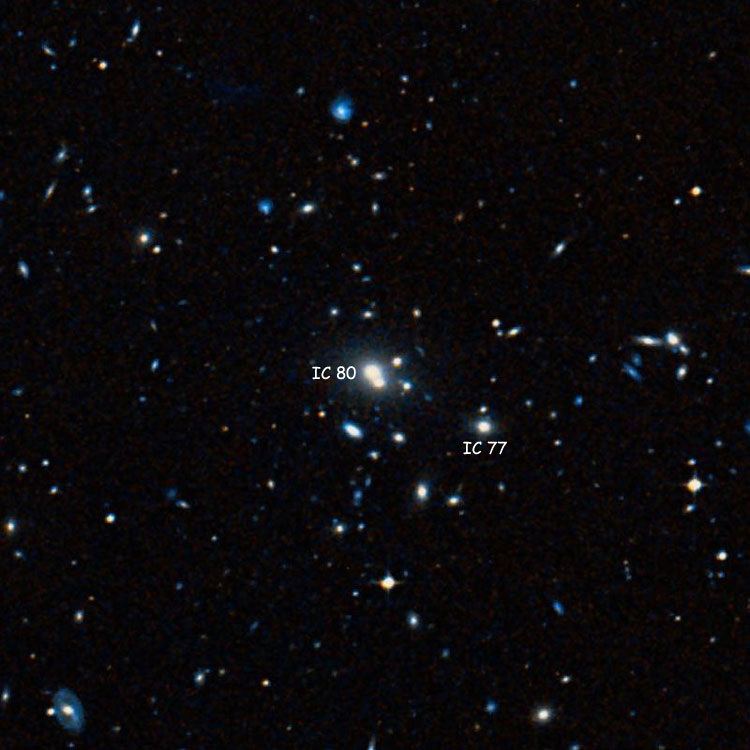
Above, a 12 arcmin wide DSS image centered on IC 80, also showing IC 77
Below, a 5 arcmin wide DSS image centered on IC 80, to allow for labeling of its neighbors
(including PGC 4070, 4081, 73652, 73654, 73656, 73658, and 73659)
Below, a 0.75 arcmin wide DSS image of the galaxy pair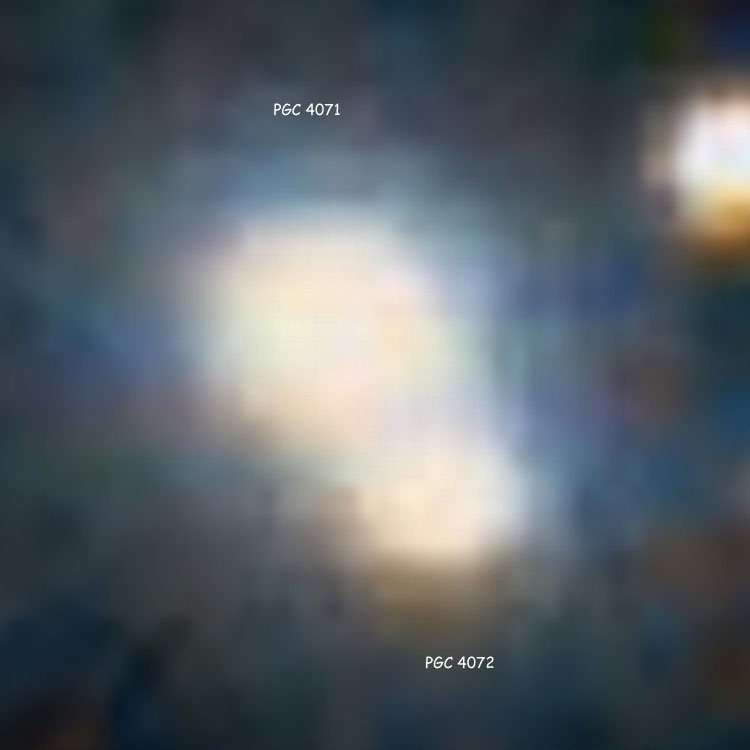
PGC 4074 (sometimes listed as but not = "IC 80B")
Not an IC object but listed here since sometimes (incorrectly) called IC 80B
A magnitude 15.7 spiral galaxy (type SABb? pec) in Cetus (RA 01 08 53.2, Dec -15 20 12)
Historical Misidentification: I cannot find the reason this object is sometimes called IC 80B, as that deprecated appellation is usually applied to PGC 4072, the fainter component of IC 80. But since PGC 4074 is sometimes listed that way, this entry serves as a warning that aside from such non-standard designations always being a bad idea, in this case it has led to a completely ridiculous result.
Physical Information: Based on a recessional velocity of 15525 km/sec, a straightforward calculation indicates that PGC 4074 is about 725 million light years away. However, for objects at such distances we should take into account the expansion of the Universe during the time it took their light to reach us. Doing that shows that the galaxy was about 680 million light years away at the time the light by which we see it was emitted, about 700 million years ago (the difference between the two numbers being due to the expansion of the intervening space during the light-travel time). Given that and its apparent size of 0.4 by 0.35 arcmin, the galaxy is about 80 thousand light years across.

Above, a 12 arcmin wide DSS image centered on PGC 4074, also showing IC 80
Below, a 0.6 arcmin wide DSS image of the galaxy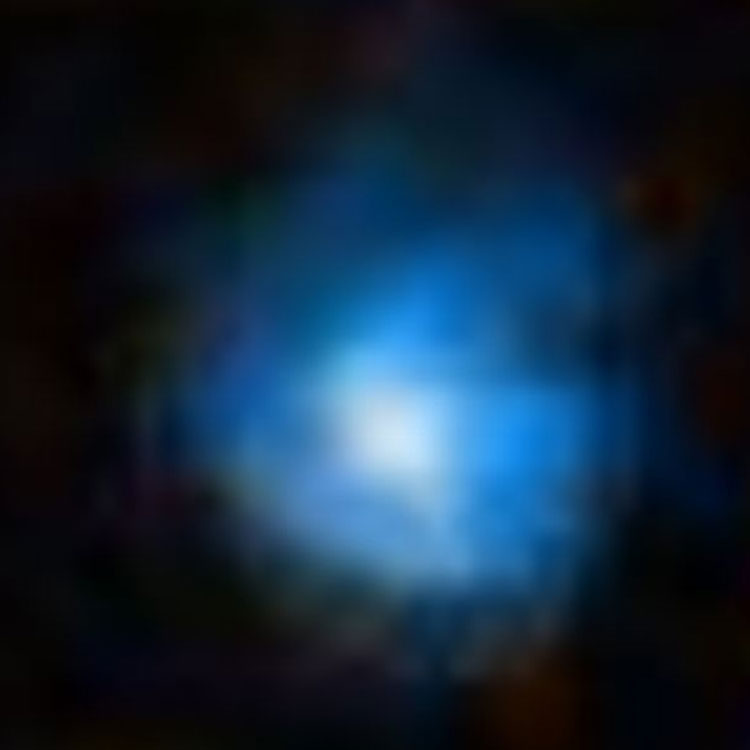
IC 81 (= PGC 4127)
Discovered (Oct 18, 1887) by Lewis Swift
Also observed (Jul 1, 1899 to Jun 30, 1900) by Herbert Howe
A magnitude 13.8 lenticular galaxy (type E/S0?) in Cetus (RA 01 09 22.3, Dec -01 41 45)
Historical Identification: Per Dreyer, IC 81 (Swift list VII (#2), 1860 RA 01 02 03, NPD 92 26.1) is "extremely faint, small, a little extended, star close to northeast". The IC2 adds (per Howe) "The star is 1 arcmin east southeast; RA is 01 02 14". The position in Howe's paper (which precesses to (1860) RA 01 02 13.7, Dec -02 26 40, essentially agreeing with Dreyer's revised NGC/IC position) precesses to RA 01 09 22.1, Dec -01 41 48, right on the galaxy listed above, and the star to the southeast makes the identification certain.
Physical Information: Based on a recessional velocity of 3950 km/sec, IC 81 is about 185 million light years away. Given that and its apparent size of 1.0 by 0.7 arcmin, it is about 55 thousand light years across.
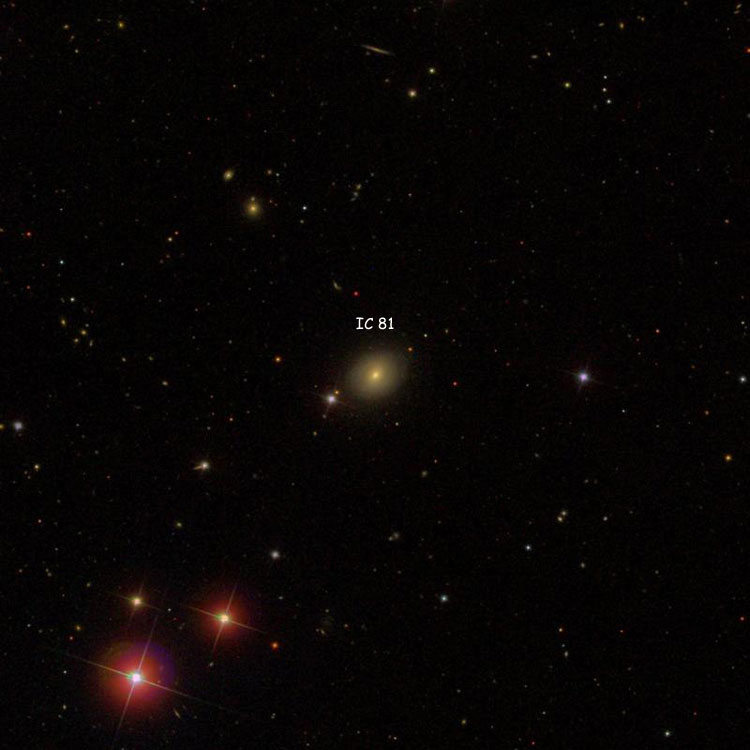
Above, a 12 arcmin wide SDSS image centered on IC 81
Below, a 1.2 arcmin wide SDSS image of the galaxy
IC 82 (= PGC 4103)
Discovered (Aug 30, 1892) by Stephane Javelle
A magnitude 13.8 spiral galaxy (type Sab?) in Cetus (RA 01 09 05.8, Dec -16 00 01)
Historical Identification: Per Dreyer, IC 82 (Javelle 45, 1860 RA 01 02 11, NPD 106 44.7) is "faint, small, gradually brighter middle". The position precesses to RA 01 09 05.8, Dec -15 59 50, within the northern outline of the galaxy listed above and there is nothing comparable nearby, so the identification is certain.
Physical Information: Two recessional velocities (11955 km/sec and 16110 km/sec) are listed for IC 82. The lower value would put it in galaxy cluster Abell 151, while the higher value would make it an outlying member of Abell 166 (which is the case with many of the galaxies listed as members of Abell 151). Based on a recessional velocity of 11955 km/sec, a straightforward calculation would indicate that IC 82 is 560 million light years away, while a similar calculation for a recesssional velocity of 16110 km/sec would indicate that it is 750 million light years away. However, for objects at such distances we should take into account the expansion of the Universe during the time it took their light to reach us. Doing that shows that if the recessional velocity is 11955 km/sec, the galaxy was about 530 million light years away at the time the light by which we see it was emitted, about 540 million years ago (the difference between the two numbers being due to the expansion of the intervening space during the light-travel time); while if the recessional velocity is 16110 km/sec, the galaxy was about 705 million light years away at the time the light by which we see it was emitted, about 725 million years ago (the difference between the two numbers being due to the expansion of the intervening space during the light-travel time). Given that and its apparent size of 1.75 by 1.5 arcmin, if the nearer distance is correct the galaxy is about 270 thousand light years across, while if the greater distance is correct, the galaxy is about 360 thousand light years across.

Above, a 12 arcmin wide DSS image centered on IC 82, also showing IC 79
Below, a 2.2 arcmin wide DSS image of the galaxy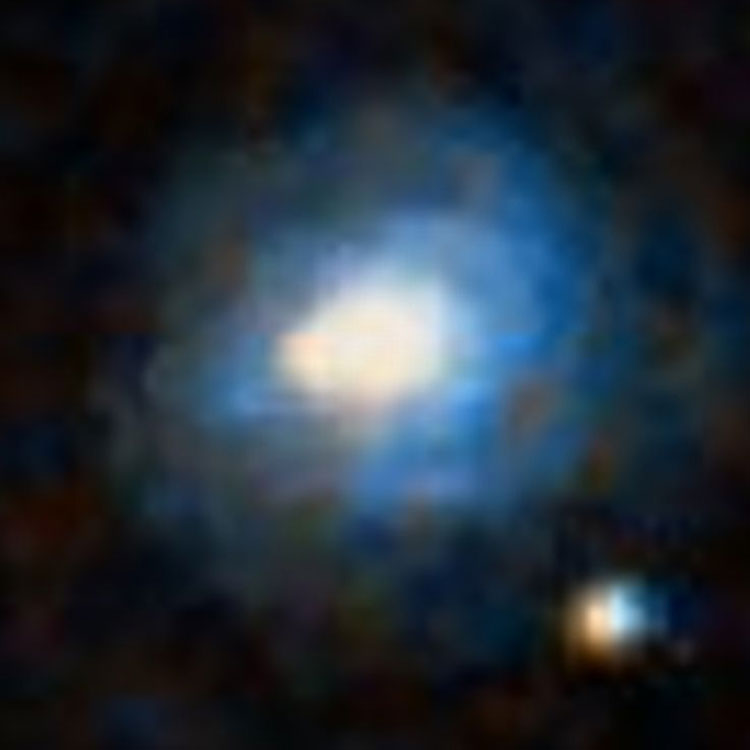
PGC 4100
Not an IC object but listed here as a possible companion of IC 82
A magnitude 16(?) spiral galaxy (type Sab?) in Cetus (RA 01 09 02.5, Dec -16 00 34)
Physical Information: LEDA B 16.6, I 14.8; NED Vr 12787 or 16730 km/sec, Sb, probably two Vr's for same reason as IC 82
IC 83 (= PGC 4182)
Discovered (Nov 5, 1891) by Stephane Javelle
A magnitude 14.6 spiral galaxy (type SAB(rs)ab?) in Cetus (RA 01 10 29.8, Dec +01 41 22)
Historical Identification: Per Dreyer, IC 83 (Javelle 46, 1860 RA 01 03 15, NPD 89 02.3) is "faint, small, diffuse, a little brighter middle". The position precesses to RA 01 10 26.5, Dec +01 42 30, about 1.4 arcmin northwest of the galaxy listed above, but there is nothing else nearby, so the identification is certain. (Javelle had a nearly identical offset for IC 84, which he discovered on the same night, so he presumably made a similar mistake, most likely in identifying his comparison star or in recording its position.)
Physical Information: Based on a recessional velocity of 13355 km/sec, a straightforward calculation indicates that IC 83 is about 620 million light years away. However, for objects at such distances we should take into account the expansion of the Universe during the time it took their light to reach us. Doing that shows that the galaxy was about 590 million light years away at the time the light by which we see it was emitted, about 605 million years ago (the difference between the two numbers being due to the expansion of the intervening space during the light-travel time). Given that and its apparent size of 0.65 by 0.4 arcmin, the galaxy is about 110 thousand light years across. IC 83 is listed as a member of galaxy cluster Abell 147.
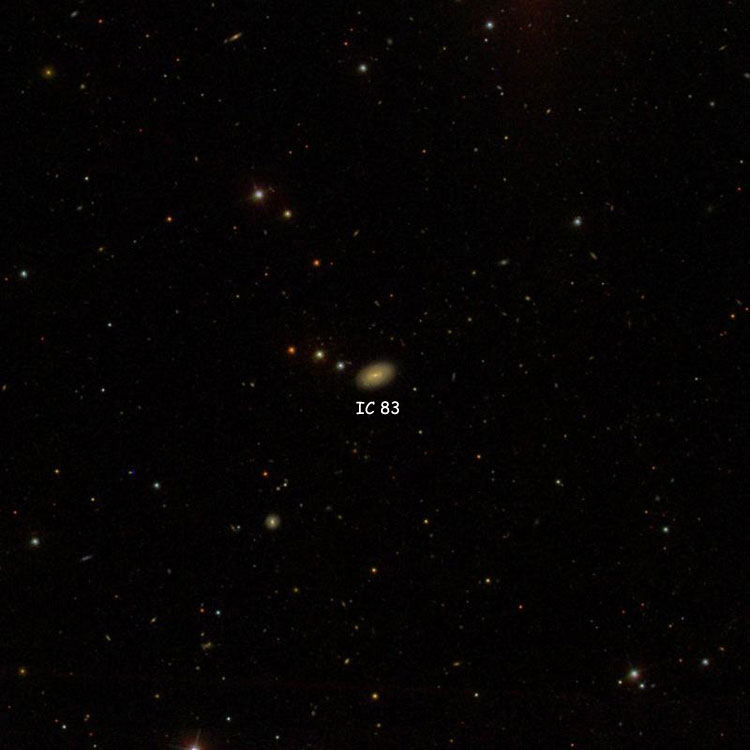
Above, a 12 arcmin wide SDSS image centered on IC 83
Below, a 0.8 arcmin wide SDSS image of the galaxy
IC 84 (= PGC 4265)
Discovered (Nov 5, 1891) by Stephane Javelle
A magnitude 14.6 lenticular galaxy (type S0/a?) in Cetus (RA 01 11 25.6, Dec +01 38 25)
Historical Identification: Per Dreyer, IC 84 (Javelle 47, 1860 RA 01 04 11, NPD 89 05.3) is "pretty bright, small, irregular figure, brighter middle". The position precesses to RA 01 11 22.5, Dec +01 39 26, about 1.3 arcmin northwest of the galaxy listed above, but there is nothing else nearby, so the identification is certain. (Javelle had a nearly identical offset for IC 83, which he discovered on the same night, so he presumably made a similar mistake, most likely in identifying his comparison star or in recording its position.)
Physical Information: Based on a recessional velocity of 5010 km/sec, IC 84 is about 235 million light years away. Given that and its apparent size of 0.6 by 0.25 arcmin, it is about 40 thousand light years across. Like IC 83, IC 84 is listed as a member of galaxy cluster Abell 147, but it is less than half as distant as the cluster, so it is actually a foreground object.
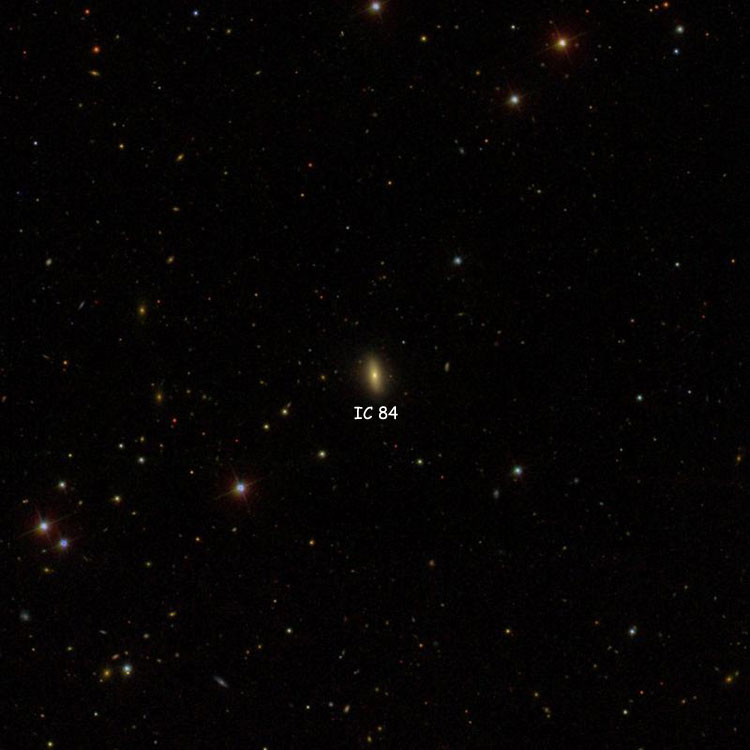
Above, a 12 arcmin wide SDSS image centered on IC 84
Below, a 0.8 arcmin wide SDSS image of the galaxy
IC 85
Recorded (Dec 6, 1888) by Guillaume Bigourdan
A nonexistent object in Cetus (RA 01 11 46.5, Dec -00 28 17)
or a nonexistent object near RA 01 11 56.3, Dec -00 25 58
Corwin lists several positions for 85.1, 85.2 and 85.3; need to see what the heck is going on here before finalizing page
Historical Identification: Per Dreyer, IC 85 (Bigourdan 113, 1860 RA 01 04 37, NPD 91 13) is "extremely faint, close to 8th magnitude star". The position precesses to RA 01 11 46.5, Dec -00 28 17 (whence the first position listed above), about 2 arcmin southwest of 8th magnitude HD 7162, but there is nothing nearby that Bigourdan could have possibly seen, so as in the case of many of Bigourdan's faint objects, this probably corresponds to a star or to a nonexistent object. As in all such cases I checked Bigourdan's original papers only to find (with the help of Corwin's notes) that Bigourdan 113 corresponds to at least two completely different objects, with four completely different positions! So to say that Bigourdan made a mess of this entry would be an understatement.
Bigourdan's first publication, in 1891, is undoubtedly the one that Dreyer referred to, as it has exactly the same (1860) position given by Dreyer, and the description is essentially the same. But his second publication, a 1902 paper giving all the gory details about observations of objects with (1900) right ascensions of 1 hour, reads "Bigourdan 113, 1888 December 6 � 13.5 magnitude star, approximately 2.7 arcmin from NGC 430 at position angle 125�. It appears preceded by excessively faint cloudiness, and the star itself could be a bit nebulous." Since NGC 430 is about 20 arcmin northeast of HD 7162, we are talking about a completely different region and a completely different object. There is one good thing about this observation, namely that there is a magnitude 14.3 double star in about the right position (2 arcmin from NGC 430, at a position angle of 120�), but it is certainly not the object Dreyer listed as IC 85.
To further muddy the waters, in the introduction to a 1907 paper Bigourdan lists two entries for Bigourdan 113. The first, in a table of all his numbered "novae" in order of right ascension gives a position of (1900) RA 01 07 33, Dec -00 47, which precesses to J2000 RA 01 12 40.0, Dec -00 15 09, about 17 arcmin northeast of HD 7162 and 5 arcmin due west of NGC 430; but although it agrees with the 1902 paper that Bigourdan 113 is near NGC 430, the position is so different from the other position near NGC 430 that they can't have anything to do with each other; and despite the fact that the position has nothing to do with Dreyer's listing, Bigourdan states that it is IC 85. Worse yet, in a table of "complementary observations" in the same paper Bigourdan lists a nova observed on Dec 6, 1888 about 5.2 seconds of time to the east and 45 arcsec north of HD 7162 (whence the second position listed above), which presumably corresponds to the original IC 85, but is in a completely different position from the original paper.
So what should we do with this mess? How many observations did Bigourdan make on the night in question, which (if any) are correctly represented by the four different entries, and which (if any) represents IC 85? We will probably never know the answers to most of these questions, but we can draw some conclusions:
Conclusion: The NGC/IC catalogs were compiled by Dreyer, so IC 85 should be in some way related to Dreyer's original entry for that object, and therefore must represent something near HD 7162. So the rest of this entry is based on the assumption that Bigourdan's supposed observations near that star are the only ones of any importance for IC 85; and the ones near NGC 430 have been relegated to the entry for Bigourdan 113-2 immediately following.
As discussed in the caption for the image below, the empty boxes near HD 7162 represent the two positions listed by Bigourdan for his #113 that were near HD 7162. Only something near one of those positions can reasonably be considered a candidate for IC 85, but there is nothing near either box that Bigourdan could possibly have seen. Therefore, regardless of which (if either) of the positions correctly represents what Bigourdan thought he saw, IC 85 must be a nonexistent object.

Above, a 6 arcmin wide SDSS image centered on HD 7162, showing the supposed positions for Bigourdan 113 that were near that star. The box on the lower right shows the position from the 1891 paper that Dreyer used to define IC 85; the one on the upper left shows the position from the table of "complementary positions" in Bigourdan's 1907 paper.
Bigourdan 113-2 (not = IC 85)
Not an IC entry, but listed here because of the confusion concerning the identity of IC 85
Recorded (Dec 6, 1888) by Guillaume Bigourdan
A magnitude 14.3 double star in Cetus (RA 01 13 06.9, Dec -00 16 07)
or a nonexistent object near RA 01 13 08.8, Dec -00 16 43 (Bigourdan's southeastern position)
or a nonexistent object near RA 01 12 40.0, Dec -00 15 09 (Bigourdan's western position)
Historical Identification: See IC 85 for a discussion of the mess Bigourdan made of his observation(s?) of Dec 6, 1888. The supposed observations near NGC 430 cannot correspond to IC 85, since Dreyer's listing for that object was based on Bigourdan's supposed observation of a nebulous star near HD 7162. But since two of the four entries for Bigourdan 113 were located near NGC 430, it can't hurt to see whether Bigourdan 113 might have represented something near that galaxy (it can't really help, either; but that's another matter).
Conclusion: The image below shows the positions of Bigourdan's supposed measurements relative to NGC 430. The empty box to the west of the galaxy represents the position in Bigourdan's 1907 paper, while the one to its southeast represents the position in his 1902 paper (per Corwin). There is nothing near the western position, hence the identification of its position (above) as a nonexistent object; but there is a double star 0.75 arcmin northwest of the southeastern position (at a distance of about 2 arcmin and a position angle of about 120� from NGC 430), hence its tentative identification as the only possibly real object recorded as Bigourdan 113. However, even if the double does correspond to one of the entries for Bigourdan 113, it cannot be IC 85, as noted above.

Above, a 12 arcmin wide SDSS image centered on NGC 430, using (empty) boxes to show the supposed positions for Bigourdan 113 that were somewhere near that galaxy. The double star that may (or may not) be the only thing Bigourdan actually observed is labeled B113(?), the question mark being perhaps the most significant part of this entire discussion.
IC 86 (= PGC 165316)
Discovered (Sep 2, 1892) by Stephane Javelle
A magnitude 14.7 spiral galaxy (type SBab?) in Cetus (RA 01 13 28.5, Dec -16 14 30)
Historical Identification: Per Dreyer, IC 86 (Javelle 48, 1860 RA 01 06 36, NPD 106 59.0) is "faint, suddenly brighter middle". The position precesses to RA 01 13 29.5, Dec -16 14 24, which is just outside the eastern rim of the galaxy listed above (about 0.3 arcmin from the center of the galaxy) and there is nothing else nearby, so the identification is certain. (Thomson states that Javelle's position is good, but Dreyer miscalculated the precessional correction, so presumably Javelle's original position was accurate to an even smaller fraction of an arcminute.)
Physical Information: Based on a recessional velocity of 13180 km/sec, a straightforward calculation indicates that IC 86 is about 615 million light years away. However, for objects at such distances we should take into account the expansion of the Universe during the time it took their light to reach us. Doing that shows that the galaxy was about 585 million light years away at the time the light by which we see it was emitted, about 595 million years ago (the difference between the two numbers being due to the expansion of the intervening space during the light-travel time). Given that and its apparent size of 0.65 by 0.35 arcmin (measured from the images below), the galaxy is about 110 thousand light years across.
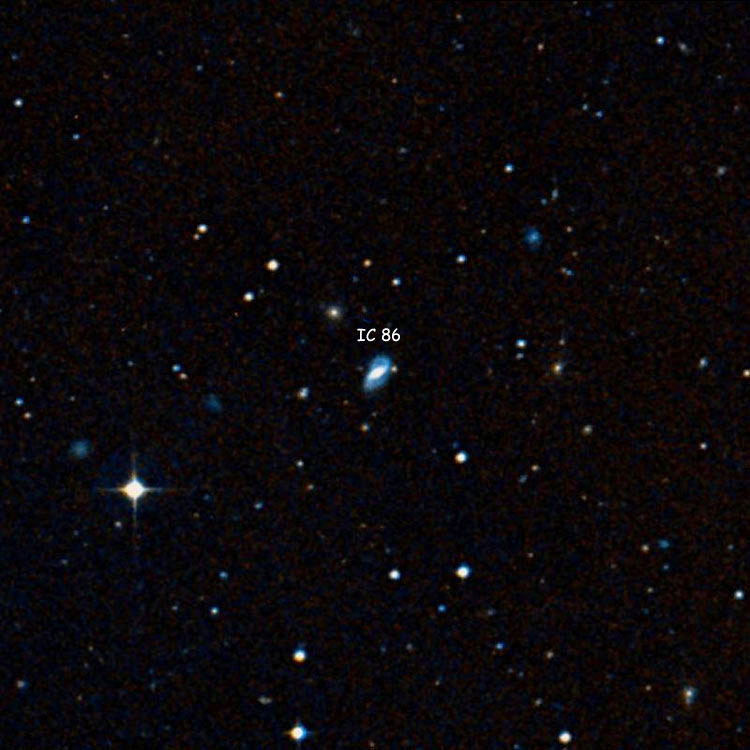
Above, a 12 arcmin wide DSS image centered on IC 86
Below, a 0.8 arcmin wide DSS image centered on the galaxy
IC 87 (= PGC 4454)
Discovered (Dec 12, 1893) by Stephane Javelle
A magnitude 14.4 spiral galaxy (type SABbc?) in Cetus (RA 01 14 15.8, Dec +00 45 55)
Historical Identification: Per Dreyer, IC 87 (Javelle 519, 1860 RA 01 07 04, NPD 89 58.3) is "faint, pretty small, round, diffuse". The position precesses to RA 01 14 14.7, Dec +00 46 16, only 0.45 arcmin northwest of the galaxy listed above and there is nothing comparable nearby, so the identification is certain. (Per Corwin, even the small error in the position is due to an error in the position of Javelle's comparison star.)
Physical Information: Based on a recessional velocity of 12740 km/sec, a straightforward calculation indicates that IC 87 is about 595 million light years away. However, for objects at such distances we should take into account the expansion of the Universe during the time it took their light to reach us. Doing that shows that the galaxy was about 565 million light years away at the time the light by which we see it was emitted, about 575 million years ago (the difference between the two numbers being due to the expansion of the intervening space during the light-travel time). Given that and its apparent size of 0.6 by 0.5 arcmin, it is about 100 thousand light years across.

Above, a 12 arcmin wide SDSS image centered on IC 87, also showing IC 88
Below, a 0.8 arcmin wide SDSS image of the galaxy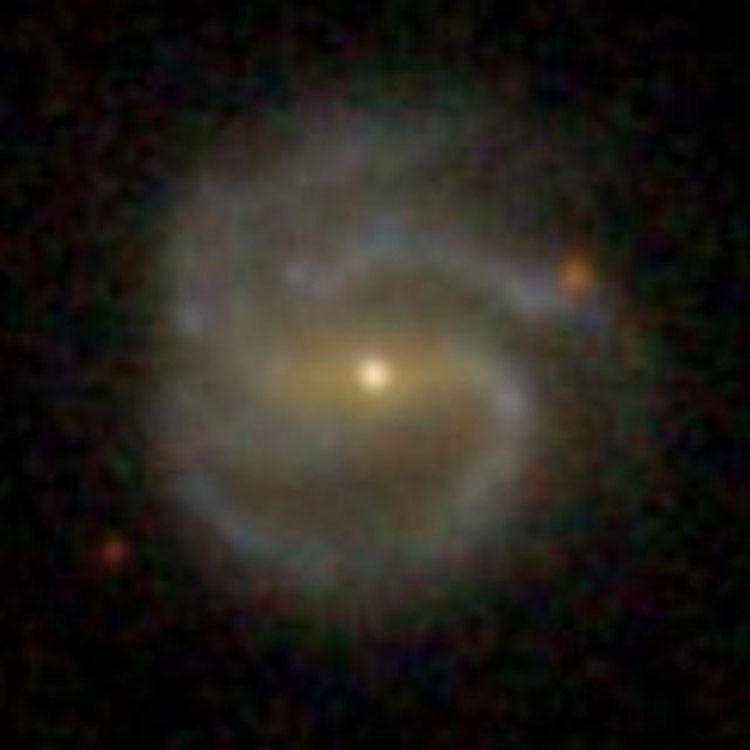
IC 88 (= PGC 1175571)
Discovered (Dec 12, 1893) by Stephane Javelle
A magnitude 15.3 spiral galaxy (type SABbc?) in Cetus (RA 01 14 31.3, Dec +00 47 30)
Historical Identification: Per Dreyer, IC 88 (Javelle 520, 1860 RA 01 07 19, NPD 89 56.8) is "pretty faint, small, round, very little brighter middle". The position precesses to RA 01 14 29.7, Dec +00 47 45, less than 0.5 arcmin west northwest of the galaxy listed above and there is nothing comparable nearby, so the identification is certain. (Per Corwin, even the small error in the position is due to an error in the position of Javelle's comparison star.) Despite this, (again per Corwin) MCG and LEDA misidentify IC 88 as PGC 4455 (which see below), and several other references copy the error (fortunately, NED has the correct identification), so it is best to use the position or correct PGC number to refer to IC 88.
Physical Information: Based on a recessional velocity of 19585 km/sec, a straightforward calculation indicates that IC 88 is about 910 million light years away. However, for objects at such distances we should take into account the expansion of the Universe during the time it took their light to reach us. Doing that shows that the galaxy was about 845 million light years away at the time the light by which we see it was emitted, about 870 million years ago (the difference between the two numbers being due to the expansion of the intervening space during the light-travel time). Given that and its apparent size of 0.4 by 0.4 arcmin, it is about 100 thousand light years across. Listed as a Seyfert galaxy (type Sy1).

Above, a 12 arcmin wide SDSS image centered on IC 88, also showing IC 87
Below, a 0.6 arcmin wide SDSS image of the galaxy
PGC 4455 (not = IC 88)
Not an IC object but listed here since often misidentified as IC 88
A 16.5(?) magnitude irregular galaxy (type Irr?) in Cetus (RA 01 14 20.5, Dec +00 55 00)
Historical Misidentification: Commonly misidentified as IC 88, as noted at that entry, hence placed here as a warning.
Physical Information: Based on a recessional velocity of 1130 km/sec, PGC 4455 is about 55 million light years away, although given the relatively small velocity, peculiar (non-Hubble redshift) velocities could considerably alter this result. Given that and its apparent size of 0.65 by 0.25 arcmin, it is about 10 thousand light years across, making it a dwarf irregular.

Above, a 12 arcmin wide SDSS image centered on PGC 4455
Below, a 0.8 arcmin wide SDSS image of the galaxy
IC 89 (= NGC 446 = PGC 4578)
Discovered (Oct 23, 1864) by Albert Marth (and later listed as NGC 446)
Discovered (Aug 20, 1892) by Stephane Javelle (and later listed as IC 89)
A magnitude 12.4 lenticular galaxy (type (R)SAB0(r)a?) in Pisces (RA 01 16 03.6, Dec +04 17 39)
Historical Identification: Per Dreyer, IC 89 (Javelle 49, 1860 RA 01 08 48, NPD 86 27.0) is "faint, small, irregular figure, nucleus equal to 13th magnitude star; 462 to the east", 462 being NGC 462, which lies half a degree to the east of the galaxy listed above. The position precesses to RA 01 16 02.3, Dec +04 17 27, less than 0.4 arcmin from the center of the galaxy listed above and barely off the southwestern rim of the bright core of the galaxy, the description fits and there is nothing else nearby, so the identification is certain. (Per Corwin, Javelle's position was dead on after correcting for errors in the position of his comparison star.) For a discussion of the double listing, which was due to an error in Marth's position, see NGC 446.
Physical Information: Given the duplicate entry, see NGC 446 for anything else.
IC 90 (= PGC 4606)
Discovered (Jan 2, 1889) by N. M. Parrish
Published in a catalog of Southern Nebulae by Ormond Stone
A magnitude 13.6 elliptical galaxy (type E2?) in Cetus (RA 01 16 30.3, Dec -07 58 37)
Historical Identification: Per Dreyer, IC 90 (Ormond Stone (#19), 1860 RA 01 09 29, NPD 98 43.0) is "bright, very small, suddenly brighter middle and nucleus". The position precesses to RA 01 16 30.7, Dec -07 58 35, within the northeastern outline of the galaxy listed above, the description fits and there is nothing comparable nearby, so the identification is certain. (Although Stone authored the paper noted by Dreyer, its entry for this object shows that it was actually observed by Parrish.)
Physical Information: Based on a recessional velocity of 5550 km/sec, IC 90 is about 260 million light years away. Given that and its apparent size of 1.6 by 1.3 arcmin, it is about 120 thousand light years across.

Above, a 12 arcmin wide SDSS image centered on IC 90
Below, a 1.6 arcmin wide SDSS image of the galaxy
IC 91 (= PGC 1230543)
Discovered (Jan 8, 1894) by Stephane Javelle
A magnitude 15.7 spiral galaxy (type S(rs)b?) in Cetus (RA 01 18 39.4, Dec +02 33 13)
Historical Identification: Per Dreyer, IC 91 (Javelle 521, 1860 RA 01 11 28, NPD 88 11.1) is "faint, small, mottled but not resolved, nucleus equal to 14th magnitude star". The position precesses to RA 01 18 40.6, Dec +02 33 11, only 0.3 arcmin east of the nucleus of the galaxy listed above and barely beyond its eastern rim, and there is nothing else nearby, so the identification is certain. (Note: A Wikisky search for IC 91 centers well to the southeast of the galaxy; but a search for PGC 1230543 centers right on the galaxy.)
Physical Information: Based on a recessional velocity of 7055 km/sec, a straightforward calculation indicates that IC 91 is about 330 million light years away. However, for objects at such distances we should take into account the expansion of the Universe during the time it took their light to reach us. Doing that shows that the galaxy was about 320 million light years away at the time the light by which we see it was emitted, about 325 million years ago (the difference between the two numbers being due to the expansion of the intervening space during the light-travel time). Given that and its apparent size of 0.6 by 0.2 arcmin, it is about 55 thousand light years across.
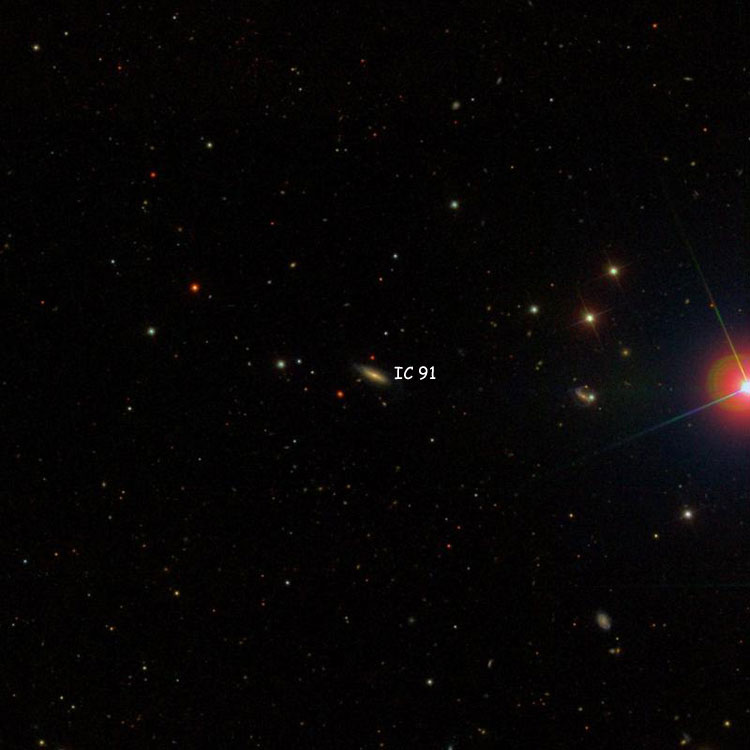
Above, a 12 arcmin wide SDSS image centered on IC 91
Below, a 0.8 arcmin wide SDSS image of the galaxy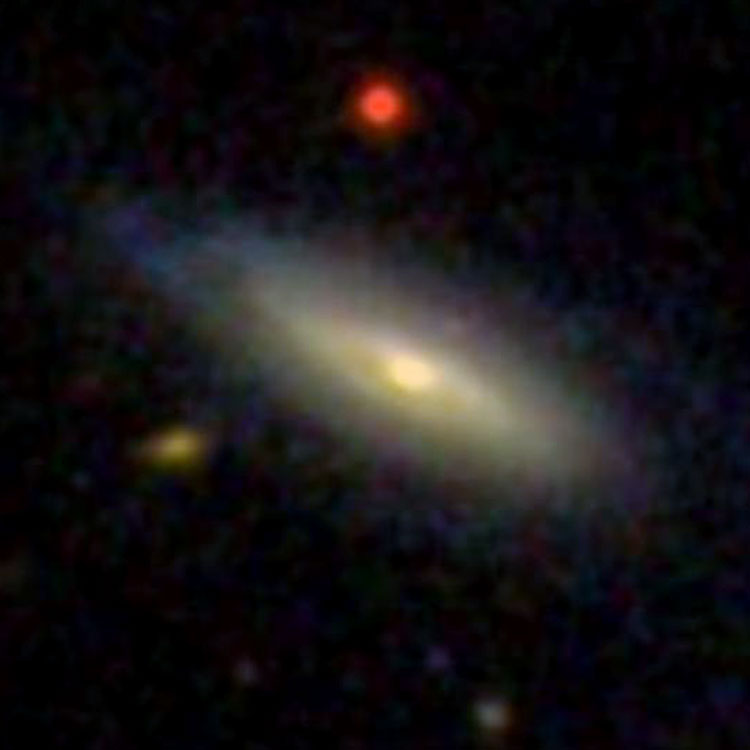
IC 92 (= PGC 4780, generally presumed to be, but not = NGC 468)
Discovered (Nov 2, 1885) by Guillaume Bigourdan (and later listed as IC 92)
A magnitude 14.3 spiral galaxy (type SAB(rs)bc?) in Pisces (RA 01 19 48.4, Dec +32 46 04)
Historical Identification: Per Dreyer, IC 92 (Bigourdan 115, 1860 RA 01 12 04, NPD 57 59) is "most extremely faint [different from h 98?]", (JH) 98 being NGC 468). The position precesses to RA 01 19 52.9, Dec +32 45 13, about 1.3 arcmin southeast of the galaxy listed above and there is nothing else nearby, so the identification is certain. (As it happens, the position of Bigourdan's comparison star is nearly half an arcmin north of the position available to him, so using his original measurements corrected for that error yields a position of RA 01 19 51.8, Dec +32 45 55, only 0.7 arcmin east southeast of the galaxy.)
Discovery Notes: Despite Dreyer's suspicion that IC 92 might be different from h98 and their positions being different enough to ensure that he gave them separate entries, IC 92 and NGC 468 were generally considered to be the same object since their identification as such by the MCG about half a century before this writing; however, as a result of a query by me in March of 2015 Dr. Corwin has confirmed that NGC 468 is actually a duplicate of NGC 472 and is not IC 92, hence the unusual title for this entry.
Physical Information: Based on a recessional velocity of 5060 km/sec, IC 92 is about 235 million light years away. Given that and its apparent size of 0.75 by 0.45 arcmin, the galaxy is about 50 thousand light years across.

Above, a 12 arcmin wide SDSS image centered on IC 92, also showing IC 94
Below, a 1 arcmin wide SDSS image of the galaxy
Per Corwin, there is a superimposed "companion" at RA 01 19 49.1, Dec +32 45 52
2MASS J01194906+3245517 is a far distant object, with a 3K Vr of 87735 km/sec (z 0.29265267)
Therefore, it is only an optical double, and has nothing to do with IC 94
IC 93 (= IC 1671 = PGC 4724 = PGC 889345)
Discovered (Sep 18, 1889) by Lewis Swift (and later recorded as IC 93)
"Rediscovered" (1895) by Lewis Swift (and later recorded as IC 1671)
A magnitude 13.2 spiral galaxy (type SBb? pec) in Cetus (RA 01 19 02.4, Dec -17 03 38)
Historical Identification: Per Dreyer, IC 93 (Swift list IX (#2), 1860 RA 01 12 07, NPD 107 48.3) is "very faint, pretty small, a little extended, 8th magnitude star 14 seconds of time to east and 1 arcmin to north" (14 sec east is an error by Dreyer; Swift's list puts the star 46 sec to the east). The position precesses to RA 01 18 58.3, Dec -17 04 03, just over an arcmin west southwest of the galaxy listed above, the description fits and there is nothing comparable nearby, so the identification is certain. (See IC 1671 for a discussion of the duplicate listing.)
Physical Information: Based on a recessional velocity of 5975 km/sec, IC 93 is about 280 million light years away. Given that and its apparent size of 1.15 by 0.55 arcmin, it is about 95 thousand light years across.

Above, a 12 arcmin wide DSS image centered on IC 93
Below, a 1.4 arcmin wide DSS image of the galaxy
PGC 4725
(= MCG -03-04-044)
Not an IC object but listed here as a probable companion of IC 93
A magnitude 15(?) spiral galaxy (type Sb? pec) in Cetus (RA 01 19 03.03 -17 01 25.7)
Physical Information: LEDA B 15.7, I 13.9; NED HII, .7 x .1 arcmin, 3K Vr 5672 km/sec
IC 94
Recorded (Nov 2, 1885) by Guillaume Bigourdan
A 15th magnitude star in Pisces (RA 01 20 05.4, Dec +32 43 02)
Historical Identification: Per Dreyer, IC 94 (Bigourdan 116, 1860 RA 01 12 17, NPD 58 02) is "a nebula equal to 13th magnitude star". The position precesses to RA 01 20 05.9, Dec +32 42 13, but there is nothing obvious there. That is not surprising, as Bigourdan stated that the faintest objects he could see were around magnitude 13 to 13.5, so his #116 is at the edge of his ability to observe nebulae, and under such circumstances he often recorded single stars or nonexistent objects as faint nebulae. To see whether one of the stars in the region might have been what he observed we refer to his original papers, as they contain more accurate information about the observations than Dreyer's brief summary. For his #116 Bigourdan used the comparison star BD+32 228, for which he used the (1900) position RA 01 14 39.5, Dec +32 12 32, which precesses to J2000 RA 01 20 15.1, Dec +32 44 03. The modern position of the star is nearly half an arcmin to the north of that, at RA 01 20 14.9, Dec +32 44 30. Converting that to the equinox of 1900 yields a corrected position for the comparison star of RA 01 14 39.3, Dec +32 12 59, and applying Bigourdan's offsets of -9.3s in right ascension and -1' 22" in declination, the position of his #116 should have been (1900) RA 01 14 30.0, Dec +32 11 37, which precesses to J2000 RA 01 20 05.5, Dec +32 43 08. This is not tremendously different from the NGC position, but often such a correction can determine whether there is a more of less certain identification of the object in question; and in this case the corrected position falls almost exactly on the star listed above, so the identification is certain.

Above, a 12 arcmin wide SDSS image centered on IC 94, also showing NGC 472 and IC 92
IC 95 (= PGC 950887)
Discovered (Nov 3, 1891) by Stephane Javelle
A magnitude 15.5 elliptical galaxy (type E0?) in Cetus (RA 01 19 17.9, Dec -12 34 27)
Historical Identification: Per Dreyer, IC 95 (Javelle 50, 1860 RA 01 12 22, NPD 103 18.5) is "faint, very small, diffuse, a very little brighter middle". The position precesses to RA 01 19 18.3, Dec -12 34 16, barely off the northeastern rim of the galaxy listed above and there is nothing comparable nearby, so the identification is certain.
Physical Information: Based on a recessional velocity of 13265 km/sec, a straightforward calculation indicates that IC 95 is about 615 million light years away. However, for objects at such distances we should take into account the expansion of the Universe during the time it took their light to reach us. Doing that shows that the galaxy was about 585 million light years away at the time the light by which we see it was emitted, about 600 million years ago (the difference between the two numbers being due to the expansion of the intervening space during the light-travel time). Given that and its apparent size of 0.4 by 0.4 arcmin, the galaxy is about 70 thousand light years across.
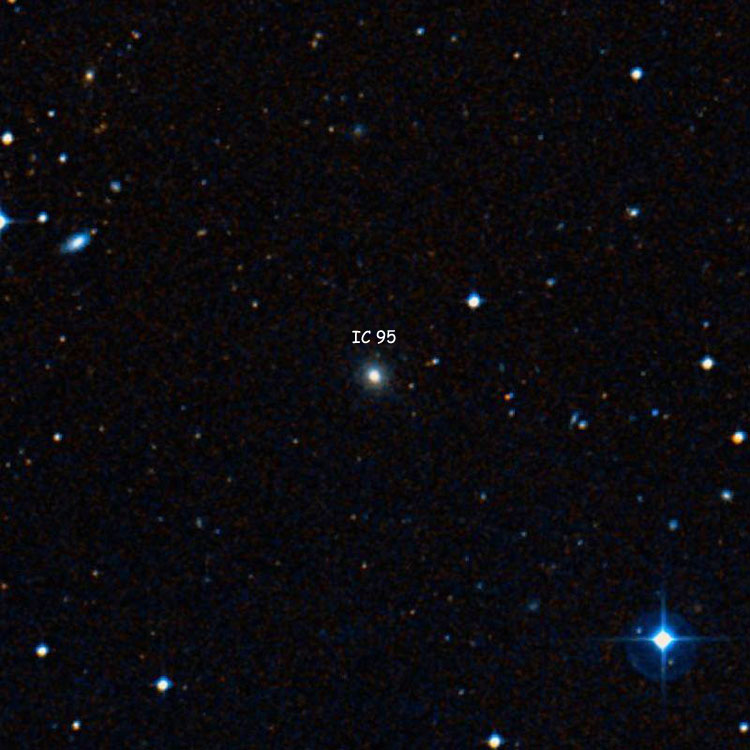
Above, a 12 arcmin wide DSS image centered on IC 95
Below, a 0.6 arcmin wide DSS image of the galaxy
WORKING HERE: CHECK BOTH IDs FOR IC 96
IC 96 (probably = IC 1672, and if so = PGC 4848)
Discovered (Dec 1, 1866) by Truman Safford (and later listed as IC 96)
Discovered (1899) by Stephane Javelle (and later listed as IC 1672)
A magnitude 13.9 spiral galaxy (type Sb?) in Pisces (RA 01 20 38.2, Dec +29 41 56)
Corwin lists IC 96 as PGC 4840
Historical Identification: Per Dreyer, IC 96 (Safford 69, 1860 RA 01 12 34, NPD 61 04.0) is "pretty bright, pretty small, very much brighter middle and nucleus equal to 12th or 13th magnitude star". The position precesses 15 to 20 seconds to the west of the correct position, depending upon which galaxy Safford observed, so the identification is uncertain. Most catalogs, including NED and Steinicke, identify IC 96 as PGC 4840. However, Thomson makes a hesitant but compelling argument that IC 96 is more likely to be PGC 4848, and if so, identical to IC 1672. As shown in the wide-field image, Safford's position was so far off that he could have observed either galaxy, but since he only mentioned one of the two galaxies, it would be more likely that he observed the brighter one, even without any knowledge of the appearance of his object. In my opinion the key is a comparison of Safford's description with the images of PGC 4840 and 4848 shown below. Both his stated appearance and brightness agree with the brighter galaxy, while neither agree with the fainter, so I have adopted Thomson's suggestion. Based on its recessional velocity of 7025 km/sec, PGC 4848 is about 315 million light years away. Given that and its apparent size of 1.3 by 1.0 arcmin, it is about 120 thousand light years across.

Above, a 1.5 arcmin wide closeup of PGC 4848, which is probably IC 96 and certainly IC 1672
Below, a 12 arcmin wide region centered on the galaxy, also showing PGC 4840
Safford's position is shown by the "+" well to the right of center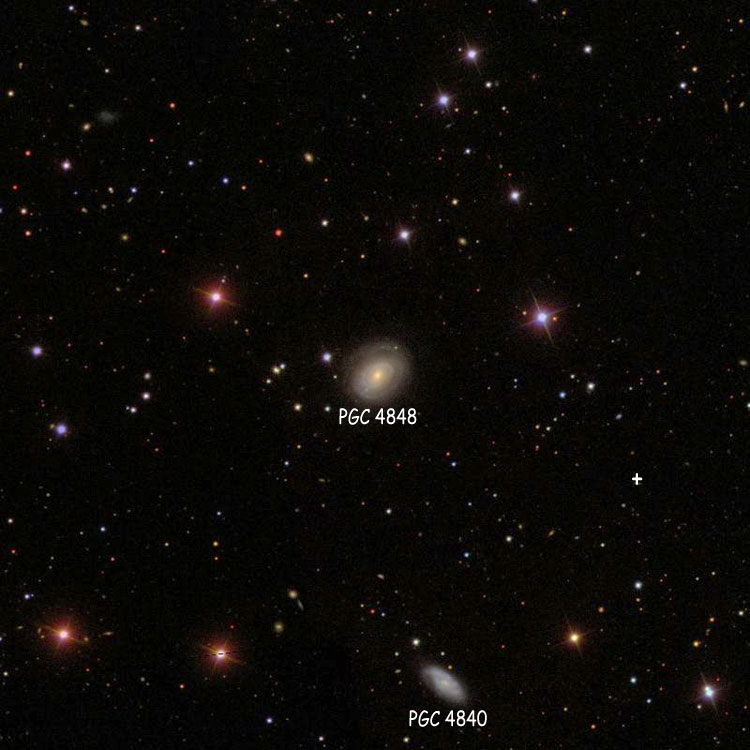
PGC 4840 (probably not IC 96)
As noted above, usually but probably incorrectly identified as IC 96
BUT listed as IC 96 by Corwin; so has he had a change of heart?
A 14th magnitude spiral galaxy (type Sbc?) in Pisces (RA 01 20 33.2, Dec +29 37 01)
Usually (but probably incorrectly) listed as IC 96, which as discussed at that entry is more likely to be PGC 4848. Based on a recessional velocity of 4405 km/sec, PGC 4840 is about 205 million light years away. Given that and its apparent size of 0.8 by 0.4 arcmin, it is almost 50 thousand light years across.

Above, a 2.4 arcmin wide closeup of PGC 4840
Below, a 12 arcmin wide region centered on the galaxy, also showing PGC 4848
IC 97 (= NGC 475 = PGC 4796)
Discovered (Nov 3, 1864) by Albert Marth (and later listed as NGC 475)
Discovered (Oct 12, 1888) by Guillaume Bigourdan (and later listed as IC 97)
A magnitude 15.0 lenticular galaxy (type S0/a?) in Pisces (RA 01 20 02.0, Dec +14 51 40)
Historical Identification: Per Dreyer, IC 97 (Bigourdan 117, 1860 RA 01 12 35, NPD 75 53) is "stellar, equal to 13.5 magnitude star". The position precesses to within 0.5 arcmin of NGC 475, so the identification is certain. Per Corwin, Marth made an accurate measurement of NGC 475, but an incorrect measurement by Peters was used by Dreyer to "correct" Marth's position. Since Bigourdan only saw a star near the incorrectly listed NGC position, he thought he had found a new nebula when he observed Marth's object. So although a duplicate observation, it was an independent discovery.
IC 98 (= PGC 4869)
Discovered (Nov 3, 1891) by Stephane Javelle
A magnitude 14.8 elliptical galaxy (type E0?) in Cetus (RA 01 20 54.9, Dec -12 36 17)
Historical Identification: Per Dreyer, IC 98 (Javelle 51, 1860 RA 01 13 59, NPD 103 20.6) is "very faint, very small, irregular figure, brighter middle". The position precesses to RA 01 20 55.0, Dec -12 36 28, barely off the southern rim of the galaxy listed above and there is nothing comparable nearby, so the identification is certain.
Physical Information: Based on a recessional velocity of 15945 km/sec, a straightforward calculation indicates that IC 98 is about 740 million light years away. However, for objects at such distances we should take into account the expansion of the Universe during the time it took their light to reach us. Doing that shows that the galaxy was about 700 million light years away at the time the light by which we see it was emitted, about 715 million years ago (the difference between the two numbers being due to the expansion of the intervening space during the light-travel time). Given that and its apparent size of 0.55 by 0.55 arcmin, it is about 110 thousand light years across.

Above, a 12 arcmin wide DSS image centered on IC 98
Below, a 0.8 arcmin wide DSS image of the galaxy
PGC 4870
(= MCG -02-04-028)
Not an IC object but listed here as a probable companion of IC 98
A magnitude 15.5(?) lenticular galaxy (type E/S0?) in Cetus (RA 01 21 00.0, Dec -12 34 14)
Physical Information: LEDA B 16.4, I 13.9; NED ?mag 15?, .2 x .2 arcmin, 3K Vr 15364 km/sec, z 0.05124833
IC 99 (= PGC 4997)
Discovered (Jan 2, 1892) by Stephane Javelle
A magnitude 14.7 spiral galaxy (type SBbc?) in Cetus (RA 01 22 27.4, Dec -12 57 09)
Historical Identification: Per Dreyer, IC 99 (Javelle 52, 1860 RA 01 15 32, NPD 103 41.1) is "very faint, small, a little brighter middle". The position precesses to RA 01 22 27.3, Dec -12 57 05, right on the galaxy listed above and there is nothing comparable nearby, so the identification is certain.
Physical Information: Based on a recessional velocity of 14770 km/sec, a straightforward calculation indicates that IC 99 is about 690 million light years away. However, for objects at such distances we should take into account the expansion of the Universe during the time it took their light to reach us. Doing that shows that the galaxy was about 650 million light years away at the time the light by which we see it was emitted, about 665 million years ago (the difference between the two numbers being due to the expansion of the intervening space during the light-travel time). Given that and its apparent size of 0.55 by 0.5 arcmin, the galaxy is about 105 thousand light years across.

Above, a 12 arcmin wide DSS image centered on IC 99
Below, a 0.7 arcmin wide DSS image of the galaxy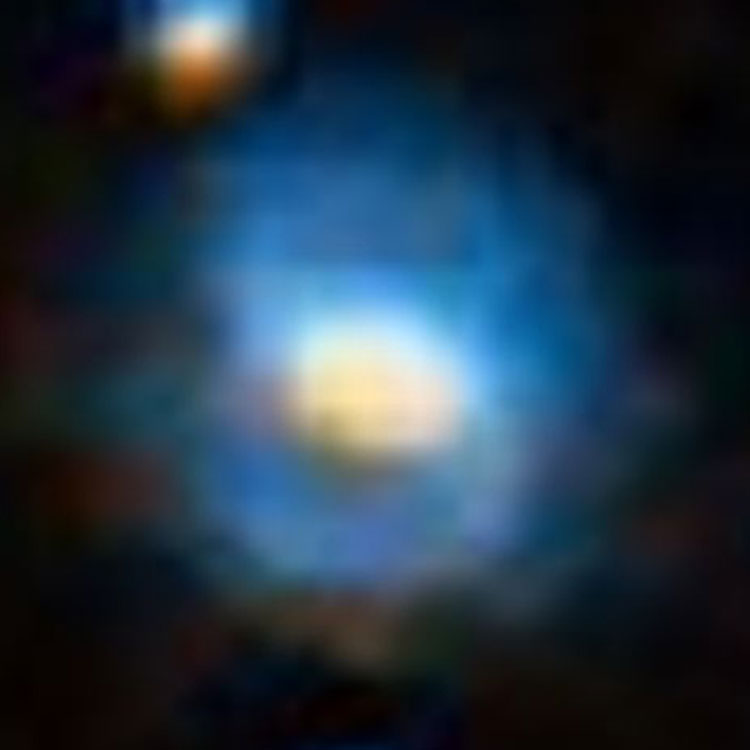
Below, a 0.7 arcmin wide PanSTARRS image of the galaxy